United States
The United States of America (USA), commonly known as the United States (U.S. or US) or America, is a country mostly located in central North America, between Canada and Mexico. It consists of 50 states, a federal district, five major self-governing territories, and various possessions.[lower-alpha 8] At 3.8 million square miles (9.8 million km2), it is the world's third- or fourth-largest country by total area.[lower-alpha 4] With a 2019 estimated population of over 328 million,[7] the U.S. is the third most populous country in the world. Americans are a racially and ethnically diverse population that has been shaped through centuries of immigration. The capital is Washington, D.C., and the most populous city is New York City.
United States of America | |
|---|---|
Motto: Other traditional mottos:
| |
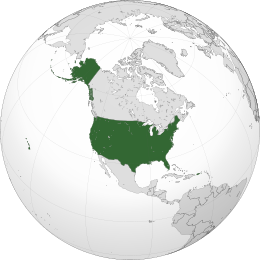 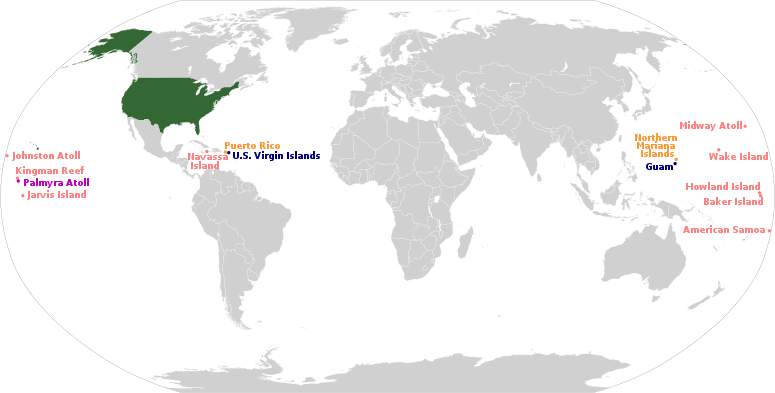 | |
| Capital | |
| Largest city | |
| Official languages | None at federal level[lower-alpha 1] |
| National language | English |
| Ethnic groups (2018)[7] | By race:
Ethnicity:
|
| Demonym(s) | American[lower-alpha 2][8] |
| Government | Federal presidential constitutional republic |
| Donald Trump (R) | |
| Mike Pence (R) | |
| Nancy Pelosi (D) | |
| John Roberts | |
| Legislature | Congress |
| Senate | |
| House of Representatives | |
| Independence from Great Britain | |
| July 4, 1776 | |
| March 1, 1781 | |
| September 3, 1783 | |
• Constitution | June 21, 1788 |
| September 25, 1789 | |
| August 21, 1959 | |
| May 5, 1992 | |
| Area | |
• Total area | 3,796,742 sq mi (9,833,520 km2)[lower-alpha 4][9] (3rd/4th) |
• Water (%) | 6.97 |
• Total land area | 3,531,905 sq mi (9,147,590 km2) |
| Population | |
• 2019 estimate | |
• 2010 census | 308,745,538[lower-alpha 5][10] (3rd) |
• Density | 87/sq mi (33.6/km2) (146th) |
| GDP (PPP) | 2020 estimate |
• Total | |
• Per capita | |
| GDP (nominal) | 2020 estimate |
• Total | |
• Per capita | |
| Gini (2018) | high · 106th |
| HDI (2018) | very high · 15th |
| Currency | United States dollar ($) (USD) |
| Time zone | UTC−4 to −12, +10, +11 |
| UTC−4 to −10[lower-alpha 6] | |
| Date format |
|
| Mains electricity | 120 V–60 Hz |
| Driving side | right[lower-alpha 7] |
| Calling code | +1 |
| ISO 3166 code | US |
| Internet TLD | |
Paleo-Indians migrated from Siberia to the North American mainland at least 12,000 years ago,[19] and European colonization began in the 16th century. The United States emerged from the thirteen British colonies established along the East Coast. Numerous disputes between Great Britain and the colonies led to the American Revolutionary War lasting between 1775 and 1783, leading to independence.[20] Beginning in the late 18th century, the United States vigorously expanded across North America, gradually acquiring new territories,[21] oftentimes killing and displacing Native Americans, and admitting new states. By 1848, the United States spanned the continent.[21] Slavery was legal in the southern United States until the second half of the 19th century, when the American Civil War led to its abolition.[22][23]
The Spanish–American War and World War I established the U.S. as a world power, a status confirmed by the outcome of World War II. It was the first country to develop nuclear weapons and is the only country to have used them in warfare. During the Cold War, the United States and the Soviet Union competed in the Space Race, culminating with the 1969 Apollo 11 mission, the spaceflight that first landed humans on the Moon. The end of the Cold War and collapse of the Soviet Union in 1991 left the United States as the world's sole superpower.[24]
The United States is a federal republic and a representative democracy. It is a founding member of the United Nations, World Bank, International Monetary Fund, Organization of American States (OAS), NATO, and other international organizations. It is a permanent member of the United Nations Security Council.
A highly developed country, the United States is the world's largest economy and accounts for approximately a quarter of global gross domestic product (GDP).[25] The United States is the world's largest importer and the second-largest exporter of goods, by value.[26][27] Although its population is only 4.3% of the world total,[28] it holds 29.4% of the total wealth in the world, the largest share held by any country.[29] Despite income and wealth disparities, the United States continues to rank high in measures of socioeconomic performance, including average wage, median income, median wealth, human development, per capita GDP, and worker productivity.[30][31] It is the foremost military power in the world, making up more than a third of global military spending,[32] and is a leading political, cultural, and scientific force internationally.[33]
Etymology
The first known use of the name "America" dates back to 1507, when it appeared on a world map created by the German cartographer Martin Waldseemüller. On this map, the name applied to South America in honor of the Italian explorer Amerigo Vespucci.[34] After returning from his expeditions, Vespucci first postulated that the West Indies did not represent Asia's eastern limit, as initially thought by Christopher Columbus, but instead were part of an entirely separate landmass thus far unknown to the Europeans.[35] In 1538, the Flemish cartographer Gerardus Mercator used the name "America" on his own world map, applying it to the entire Western Hemisphere.[36]
The first documentary evidence of the phrase "United States of America" dates from a January 2, 1776 letter written by Stephen Moylan, Esq., to Lt. Col. Joseph Reed, George Washington's aide-de-camp and Muster-Master General of the Continental Army. Moylan expressed his wish to go "with full and ample powers from the United States of America to Spain" to seek assistance in the revolutionary war effort.[37][38][39] The first known publication of the phrase "United States of America" was in an anonymous essay in The Virginia Gazette newspaper in Williamsburg, Virginia, on April 6, 1776.[40]
The second draft of the Articles of Confederation, prepared by John Dickinson and completed no later than June 17, 1776, declared "The name of this Confederation shall be the 'United States of America'".[41] The final version of the Articles sent to the states for ratification in late 1777 contains the sentence "The Stile of this Confederacy shall be 'The United States of America'".[42] In June 1776, Thomas Jefferson wrote the phrase "UNITED STATES OF AMERICA" in all capitalized letters in the headline of his "original Rough draught" of the Declaration of Independence.[41] This draft of the document did not surface until June 21, 1776, and it is unclear whether it was written before or after Dickinson used the term in his June 17 draft of the Articles of Confederation.[41]
The short form "United States" is also standard. Other common forms are the "U.S.," the "USA," and "America." Colloquial names are the "U.S. of A." and, internationally, the "States." "Columbia," a name popular in American poetry and songs of the late 18th century, derives its origin from Christopher Columbus; it appears in the name "District of Columbia." Many landmarks and institutions in the Western Hemisphere bear his name, including the country of Colombia.[43]
The phrase "United States" was originally plural, a description of a collection of independent states—e.g., "the United States are"—including in the Thirteenth Amendment to the United States Constitution, ratified in 1865.[44] The singular form—e.g., "the United States is"—became popular after the end of the Civil War. The singular form is now standard; the plural form is retained in the idiom "these United States." The difference is more significant than usage; it is a difference between a collection of states and a unit.[45]
A citizen of the United States is an "American." "United States," "American" and "U.S." refer to the country adjectivally ("American values," "U.S. forces"). In English, the word "American" rarely refers to topics or subjects not directly connected with the United States.[46]
History
Indigenous peoples and pre-Columbian history
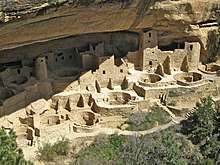
It has been generally accepted that the first inhabitants of North America migrated from Siberia by way of the Bering land bridge and arrived at least 12,000 years ago; however, increasing evidence suggests an even earlier arrival.[19][47][48] After crossing the land bridge, the Paleo-Indians moved southward along the Pacific coast[49] and through an interior ice-free corridor.[50] The Clovis culture, which appeared around 11,000 BC, was initially believed to represent the first wave of human settlement of the Americas.[51][52] It is likely these represent the first of three major waves of migration into North America.[53]
Over time, indigenous cultures in North America grew increasingly complex, and some, such as the pre-Columbian Mississippian culture in the southeast, developed advanced agriculture, grand architecture, and state-level societies.[54] The Mississippian culture flourished in the south from 800 to 1600 AD, extending from the Mexican border down through Florida.[55] Its city state Cahokia is the largest, most complex pre-Columbian archaeological site in the modern-day United States.[56] In the Four Corners region, Ancestral Puebloan culture developed from centuries of agricultural experimentation.[57]
Three UNESCO World Heritage Sites in the United States are credited to the Pueblos: Mesa Verde National Park, Chaco Culture National Historical Park, and Taos Pueblo.[58][59] The earthworks constructed by Native Americans of the Poverty Point culture have also been designated a UNESCO World Heritage site. In the southern Great Lakes region, the Iroquois Confederacy was established at some point between the twelfth and fifteenth centuries.[60] Most prominent along the Atlantic coast were the Algonquian tribes, who practiced hunting and trapping, along with limited cultivation.
Effects on and interaction with native populations
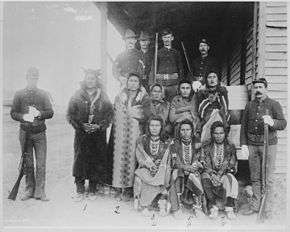
With the progress of European colonization in the territories of the contemporary United States, the Native Americans were often conquered and displaced.[61] The native population of America declined after European arrival for various reasons,[62][63] primarily diseases such as smallpox and measles.[64][65]
Estimating the native population of North America at the time of European contact is difficult.[66][67] Douglas H. Ubelaker of the Smithsonian Institution estimated that there was a population of 92,916 in the south Atlantic states and a population of 473,616 in the Gulf states,[68] but most academics regard this figure as too low.[66] Anthropologist Henry F. Dobyns believed the populations were much higher, suggesting 1,100,000 along the shores of the gulf of Mexico, 2,211,000 people living between Florida and Massachusetts, 5,250,000 in the Mississippi Valley and tributaries and 697,000 people in the Florida peninsula.[66][67]
In the early days of colonization, many European settlers were subject to food shortages, disease, and attacks from Native Americans. Native Americans were also often at war with neighboring tribes and allied with Europeans in their colonial wars. In many cases, however, natives and settlers came to depend on each other. Settlers traded for food and animal pelts; natives for guns, ammunition and other European goods.[69] Natives taught many settlers to cultivate corn, beans, and squash. European missionaries and others felt it was important to "civilize" the Native Americans and urged them to adopt European agricultural techniques and lifestyles.[70][71]
European settlements
With the advancement of European colonization in North America, the Native Americans were often conquered and displaced.[72] The first Europeans to arrive in the contiguous United States were Spanish conquistadors such as Juan Ponce de León, who made his first visit to Florida in 1513. Even earlier, Christopher Columbus landed in Puerto Rico on his 1493 voyage. The Spanish set up the first settlements in Florida and New Mexico such as Saint Augustine[73] and Santa Fe. The French established their own as well along the Mississippi River. Successful English settlement on the eastern coast of North America began with the Virginia Colony in 1607 at Jamestown and with the Pilgrims' Plymouth Colony in 1620. Many settlers were dissenting Christian groups who came seeking religious freedom. The continent's first elected legislative assembly, Virginia's House of Burgesses, was created in 1619. The Mayflower Compact, signed by the Pilgrims before disembarking, and the Fundamental Orders of Connecticut, established precedents for the pattern of representative self-government and constitutionalism that would develop throughout the American colonies.[74][75]
Most settlers in every colony were small farmers, though other industries were formed. Cash crops included tobacco, rice, and wheat. Extraction industries grew up in furs, fishing and lumber. Manufacturers produced rum and ships, and by the late colonial period, Americans were producing one-seventh of the world's iron supply.[76] Cities eventually dotted the coast to support local economies and serve as trade hubs. English colonists were supplemented by waves of Scotch-Irish immigrants and other groups. As coastal land grew more expensive, freed indentured servants claimed lands further west.[77]
A large-scale slave trade with English privateers began.[78] Because of less disease and better food and treatment, the life expectancy of slaves was much higher in North America than further south, leading to a rapid increase in the numbers of slaves.[79][80] Colonial society was largely divided over the religious and moral implications of slavery, and colonies passed acts for and against the practice.[81][82] But by the turn of the 18th century, African slaves were replacing indentured servants for cash crop labor, especially in the South.[83]
With the establishment of the Province of Georgia in 1732, the 13 colonies that would become the United States of America were administered by the British as overseas dependencies.[84] All nonetheless had local governments with elections open to most free men.[85] With extremely high birth rates, low death rates, and steady settlement, the colonial population grew rapidly. Relatively small Native American populations were eclipsed.[86] The Christian revivalist movement of the 1730s and 1740s known as the Great Awakening fueled interest both in religion and in religious liberty.[87]
During the Seven Years' War (known in the United States as the French and Indian War), British forces seized Canada from the French, but the francophone population remained politically isolated from the southern colonies. Excluding the Native Americans, who were being conquered and displaced, the 13 British colonies had a population of over 2.1 million in 1770, about a third that of Britain. Despite continuing, new arrivals, the rate of natural increase was such that by the 1770s only a small minority of Americans had been born overseas.[88] The colonies' distance from Britain had allowed the development of self-government, but their unprecedented success motivated monarchs to periodically seek to reassert royal authority.[89]
In 1774, the Spanish Navy ship Santiago, under Juan Pérez, entered and anchored in an inlet of Nootka Sound, Vancouver Island, in present-day British Columbia. Although the Spanish did not land, natives paddled to the ship to trade furs for abalone shells from California.[90] At the time, the Spanish were able to monopolize the trade between Asia and North America, granting limited licenses to the Portuguese. When the Russians began establishing a growing fur trading system in Alaska, the Spanish began to challenge the Russians, with Pérez's voyage being the first of many to the Pacific Northwest.[91][lower-alpha 9]
During his third and final voyage, Captain James Cook became the first European to begin formal contact with Hawaii.[93] Captain Cook's last voyage included sailing along the coast of North America and Alaska searching for a Northwest Passage for approximately nine months.[94]
Independence and expansion (1776–1865)
%2C_by_John_Trumbull.jpg)
The American Revolutionary War was the first successful colonial war of independence against a European power. Americans had developed an ideology of "republicanism" asserting that government rested on the will of the people as expressed in their local legislatures. They demanded their rights as Englishmen and "no taxation without representation". The British insisted on administering the empire through Parliament, and the conflict escalated into war.[95]
The Second Continental Congress unanimously adopted the Declaration of Independence, which asserted that Great Britain was not protecting Americans' unalienable rights. July 4 is celebrated annually as Independence Day.[96] In 1777, the Articles of Confederation established a decentralized government that operated until 1789.[96]
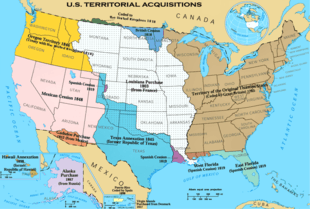
Following the decisive Franco-American victory at Yorktown in 1781,[97] Britain signed the peace treaty of 1783, and American sovereignty was internationally recognized and the country was granted all lands east of the Mississippi River. Nationalists led the Philadelphia Convention of 1787 in writing the United States Constitution, ratified in state conventions in 1788. The federal government was reorganized into three branches, on the principle of creating salutary checks and balances, in 1789. George Washington, who had led the Continental Army to victory, was the first president elected under the new constitution. The Bill of Rights, forbidding federal restriction of personal freedoms and guaranteeing a range of legal protections, was adopted in 1791.[98]
Although the federal government criminalized the international slave trade in 1808, after 1820, cultivation of the highly profitable cotton crop exploded in the Deep South, and along with it, the slave population.[99][100][101] The Second Great Awakening, especially 1800–1840, converted millions to evangelical Protestantism. In the North, it energized multiple social reform movements, including abolitionism;[102] in the South, Methodists and Baptists proselytized among slave populations.[103]
Americans' eagerness to expand westward prompted a long series of American Indian Wars.[104] The Louisiana Purchase of French-claimed territory in 1803 almost doubled the nation's area.[105] The War of 1812, declared against Britain over various grievances and fought to a draw, strengthened U.S. nationalism.[106] A series of military incursions into Florida led Spain to cede it and other Gulf Coast territory in 1819.[107] The expansion was aided by steam power, when steamboats began traveling along America's large water systems, many of which were connected by new canals, such as the Erie and the I&M; then, even faster railroads began their stretch across the nation's land.[108]
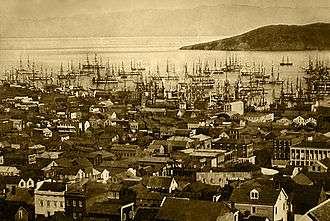
From 1820 to 1850, Jacksonian democracy began a set of reforms which included wider white male suffrage; it led to the rise of the Second Party System of Democrats and Whigs as the dominant parties from 1828 to 1854. The Trail of Tears in the 1830s exemplified the Indian removal policy that forcibly resettled Indians into the west on Indian reservations. The U.S. annexed the Republic of Texas in 1845 during a period of expansionist Manifest destiny.[109] The 1846 Oregon Treaty with Britain led to U.S. control of the present-day American Northwest.[110] Victory in the Mexican–American War resulted in the 1848 Mexican Cession of California and much of the present-day American Southwest.[111] The California Gold Rush of 1848–49 spurred migration to the Pacific coast, which led to the California Genocide[112][113][114][115] and the creation of additional western states.[116] After the Civil War, new transcontinental railways made relocation easier for settlers, expanded internal trade and increased conflicts with Native Americans.[117] In 1869, a new Peace Policy nominally promised to protect Native Americans from abuses, avoid further war, and secure their eventual U.S. citizenship. Nonetheless, large-scale conflicts continued throughout the West into the 1900s.
Civil War and Reconstruction era
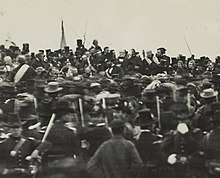
Irreconcilable sectional conflict regarding the slavery of Africans and African Americans ultimately led to the American Civil War.[118] Initially, states entering the Union had alternated between slave and free states, keeping a sectional balance in the Senate, while free states outstripped slave states in population and in the House of Representatives. But with additional western territory and more free-soil states, tensions between slave and free states mounted with arguments over federalism and disposition of the territories, as well as whether to expand or restrict slavery.[119]
With the 1860 election of Republican Abraham Lincoln, conventions in thirteen slave states ultimately declared secession and formed the Confederate States of America (the "South" or the "Confederacy"), while the federal government (the "Union") maintained that secession was illegal.[119] In order to bring about this secession, military action was initiated by the secessionists, and the Union responded in kind. The ensuing war would become the deadliest military conflict in American history, resulting in the deaths of approximately 618,000 soldiers as well as many civilians.[120] The Union initially simply fought to keep the country united. Nevertheless, as casualties mounted after 1863 and Lincoln delivered his Emancipation Proclamation, the main purpose of the war from the Union's viewpoint became the abolition of slavery. Indeed, when the Union ultimately won the war in April 1865, each of the states in the defeated South was required to ratify the Thirteenth Amendment, which prohibited slavery.
The government enacted three constitutional amendments in the years after the war: the aforementioned Thirteenth as well as the Fourteenth Amendment providing citizenship to the nearly four million African Americans who had been slaves,[121] and the Fifteenth Amendment ensuring in theory that African Americans had the right to vote. The war and its resolution led to a substantial increase in federal power[122] aimed at reintegrating and rebuilding the South while guaranteeing the rights of the newly freed slaves.
Reconstruction began in earnest following the war. While President Lincoln attempted to foster friendship and forgiveness between the Union and the former Confederacy, his assassination on April 14, 1865, drove a wedge between North and South again. Republicans in the federal government made it their goal to oversee the rebuilding of the South and to ensure the rights of African Americans. They persisted until the Compromise of 1877 when the Republicans agreed to cease protecting the rights of African Americans in the South in order for Democrats to concede the presidential election of 1876.
Southern white Democrats, calling themselves "Redeemers," took control of the South after the end of Reconstruction. From 1890 to 1910 the Redeemers established so-called Jim Crow laws, disenfranchising most blacks and some poor whites throughout the region. Blacks faced racial segregation, especially in the South.[123] They also occasionally experienced vigilante violence, including lynching.[124]
Further immigration, expansion, and industrialization

In the North, urbanization and an unprecedented influx of immigrants from Southern and Eastern Europe supplied a surplus of labor for the country's industrialization and transformed its culture.[126] National infrastructure including telegraph and transcontinental railroads spurred economic growth and greater settlement and development of the American Old West. The later invention of electric light and the telephone would also affect communication and urban life.[127]
The United States fought Indian Wars west of the Mississippi River from 1810 to at least 1890.[128] Most of these conflicts ended with the cession of Native American territory and their confinement to Indian reservations. This further expanded acreage under mechanical cultivation, increasing surpluses for international markets.[129] Mainland expansion also included the purchase of Alaska from Russia in 1867.[130] In 1893, pro-American elements in Hawaii overthrew the monarchy and formed the Republic of Hawaii, which the U.S. annexed in 1898. Puerto Rico, Guam, and the Philippines were ceded by Spain in the same year, following the Spanish–American War.[131] American Samoa was acquired by the United States in 1900 after the end of the Second Samoan Civil War.[132] The U.S. Virgin Islands were purchased from Denmark in 1917.[133]
Rapid economic development during the late 19th and early 20th centuries fostered the rise of many prominent industrialists. Tycoons like Cornelius Vanderbilt, John D. Rockefeller, and Andrew Carnegie led the nation's progress in railroad, petroleum, and steel industries. Banking became a major part of the economy, with J. P. Morgan playing a notable role. The American economy boomed, becoming the world's largest, and the United States achieved great power status.[134] These dramatic changes were accompanied by social unrest and the rise of populist, socialist, and anarchist movements.[135] This period eventually ended with the advent of the Progressive Era, which saw significant reforms including women's suffrage, alcohol prohibition, regulation of consumer goods, greater antitrust measures to ensure competition and attention to worker conditions.[136][137][138]
World War I, Great Depression, and World War II
.jpg)
The United States remained neutral from the outbreak of World War I in 1914 until 1917, when it joined the war as an "associated power," alongside the formal Allies of World War I, helping to turn the tide against the Central Powers. In 1919, President Woodrow Wilson took a leading diplomatic role at the Paris Peace Conference and advocated strongly for the U.S. to join the League of Nations. However, the Senate refused to approve this and did not ratify the Treaty of Versailles that established the League of Nations.[139]
In 1920, the women's rights movement won passage of a constitutional amendment granting women's suffrage.[140] The 1920s and 1930s saw the rise of radio for mass communication and the invention of early television.[141] The prosperity of the Roaring Twenties ended with the Wall Street Crash of 1929 and the onset of the Great Depression. After his election as president in 1932, Franklin D. Roosevelt responded with the New Deal.[142] The Great Migration of millions of African Americans out of the American South began before World War I and extended through the 1960s;[143] whereas the Dust Bowl of the mid-1930s impoverished many farming communities and spurred a new wave of western migration.[144]
At first effectively neutral during World War II, the United States began supplying materiel to the Allies in March 1941 through the Lend-Lease program. On December 7, 1941, the Empire of Japan launched a surprise attack on Pearl Harbor, prompting the United States to join the Allies against the Axis powers.[145] Although Japan attacked the United States first, the U.S. nonetheless pursued a "Europe first" defense policy.[146] The United States thus left its vast Asian colony, the Philippines, isolated and fighting a losing struggle against Japanese invasion and occupation, as military resources were devoted to the European theater. During the war, the United States was referred to as one of the "Four Policemen"[147] of Allies power who met to plan the postwar world, along with Britain, the Soviet Union and China.[148][149] Although the nation lost around 400,000 military personnel,[150] it emerged relatively undamaged from the war with even greater economic and military influence.[151]
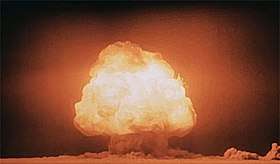
The United States played a leading role in the Bretton Woods and Yalta conferences with the United Kingdom, the Soviet Union, and other Allies, which signed agreements on new international financial institutions and Europe's postwar reorganization. As an Allied victory was won in Europe, a 1945 international conference held in San Francisco produced the United Nations Charter, which became active after the war.[152] The United States and Japan then fought each other in the largest naval battle in history, the Battle of Leyte Gulf.[153][154] The United States worked on a secret project, known as the Manhattan Project. They eventually developed the first nuclear weapons, and tested them in the Jornada del Muerto desert about 35 miles (56 km) southeast of Socorro, New Mexico. [155] This was known as the Trinity Test. The test was successful, which eventually led to the bombing of Japanese cities Hiroshima and Nagasaki; the Japanese surrendered on September 2, ending World War II.[156][157]
Cold War and civil rights era
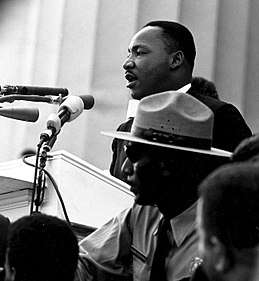
After World War II, the United States and the Soviet Union competed for power, influence, and prestige during what became known as the Cold War, driven by an ideological divide between capitalism and communism.[158] They dominated the military affairs of Europe, with the U.S. and its NATO allies on one side and the USSR and its Warsaw Pact allies on the other. The U.S. developed a policy of containment towards the expansion of communist influence. While the U.S. and Soviet Union engaged in proxy wars and developed powerful nuclear arsenals, the two countries avoided direct military conflict.
The United States often opposed Third World movements that it viewed as Soviet-sponsored, and occasionally pursued direct action for regime change against left-wing governments, even supporting right-wing authoritarian governments at times.[159] American troops fought communist Chinese and North Korean forces in the Korean War of 1950–53.[160] The Soviet Union's 1957 launch of the first artificial satellite and its 1961 launch of the first manned spaceflight initiated a "Space Race" in which the United States became the first nation to land a man on the moon in 1969.[160] A proxy war in Southeast Asia eventually evolved into full American participation, as the Vietnam War.
At home, the U.S. experienced sustained economic expansion and a rapid growth of its population and middle class. Construction of an Interstate Highway System transformed the nation's infrastructure over the following decades. Millions moved from farms and inner cities to large suburban housing developments.[161][162] In 1959 Hawaii became the 50th and last U.S. state added to the country.[163] The growing Civil Rights Movement used nonviolence to confront segregation and discrimination, with Martin Luther King Jr. becoming a prominent leader and figurehead. A combination of court decisions and legislation, culminating in the Civil Rights Act of 1968, sought to end racial discrimination.[164][165][166] Meanwhile, a counterculture movement grew which was fueled by opposition to the Vietnam war, black nationalism, and the sexual revolution.
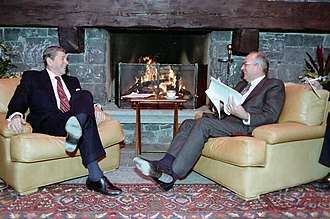
The launch of a "War on Poverty" expanded entitlements and welfare spending, including the creation of Medicare and Medicaid, two programs that provide health coverage to the elderly and poor, respectively, and the means-tested Food Stamp Program and Aid to Families with Dependent Children.[167]
The 1970s and early 1980s saw the onset of stagflation. After his election in 1980, President Ronald Reagan responded to economic stagnation with free-market oriented reforms. Following the collapse of détente, he abandoned "containment" and initiated the more aggressive "rollback" strategy towards the USSR.[168][169][170][171][172] After a surge in female labor participation over the previous decade, by 1985 the majority of women aged 16 and over were employed.[173]
The late 1980s brought a "thaw" in relations with the USSR, and its collapse in 1991 finally ended the Cold War.[174][175][176][177] This brought about unipolarity[178] with the U.S. unchallenged as the world's dominant superpower. The concept of Pax Americana, which had appeared in the post-World War II period, gained wide popularity as a term for the post-Cold War new world order.
Contemporary history

After the Cold War, the conflict in the Middle East triggered a crisis in 1990, when Iraq under Saddam Hussein invaded and attempted to annex Kuwait, an ally of the United States. Fearing the instability would spread to other regions, President George H. W. Bush launched Operation Desert Shield, a defensive force buildup in Saudi Arabia, and Operation Desert Storm, in a staging titled the Gulf War; waged by coalition forces from 34 nations, led by the United States against Iraq ending in the expulsion of Iraqi forces from Kuwait and restoration of the monarchy.[179]
Originating within U.S. military defense networks, the Internet spread to international academic platforms and then to the public in the 1990s, greatly affecting the global economy, society, and culture.[180] Due to the dot-com boom, stable monetary policy, and reduced social welfare spending, the 1990s saw the longest economic expansion in modern U.S. history.[181] Beginning in 1994, the U.S. entered into the North American Free Trade Agreement (NAFTA), prompting trade among the U.S., Canada, and Mexico to soar.[182]
On September 11, 2001, Al-Qaeda terrorists struck the World Trade Center in New York City and the Pentagon near Washington, D.C., killing nearly 3,000 people.[183] In response, the United States launched the War on Terror, which included a war in Afghanistan and the 2003–11 Iraq War.[184][185]
Government policy designed to promote affordable housing,[186] widespread failures in corporate and regulatory governance,[187] and historically low interest rates set by the Federal Reserve[188] led to the mid-2000s housing bubble, which culminated with the 2008 financial crisis, the nation's largest economic contraction since the Great Depression.[189] Barack Obama, the first African-American[190] and multiracial[191] president, was elected in 2008 amid the crisis,[192] and subsequently passed stimulus measures and the Dodd–Frank Act in an attempt to mitigate its negative effects and ensure there would not be a repeat of the crisis. In 2010, the Obama administration passed the Affordable Care Act, which made the most sweeping reforms to the nation's healthcare system in nearly five decades, including mandates, subsidies and insurance exchanges.
American forces in Iraq were withdrawn in large numbers in 2009 and 2010, and the war in the region was declared formally over in December 2011.[193] But months earlier, Operation Neptune Spear led to the death of the leader of Al-Qaeda in Pakistan.[194] In the presidential election of 2016, Republican Donald Trump was elected as the 45th president of the United States. On January 20, 2020, the first case of COVID-19 in the United States was confirmed.[195] As of August 2020, the United States has over 4.5 million COVID-19 cases and over 150,000 deaths.[196] The United States is, by far, the country with the most cases of COVID-19 since April 11, 2020.[197]
Geography, climate, and environment
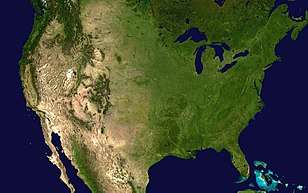
The 48 contiguous states and the District of Columbia occupy a combined area of 3,119,884.69 square miles (8,080,464.3 km2). Of this area, 2,959,064.44 square miles (7,663,941.7 km2) is contiguous land, composing 83.65% of total U.S. land area.[198][199] Hawaii, occupying an archipelago in the central Pacific, southwest of North America, is 10,931 square miles (28,311 km2) in area. The populated territories of Puerto Rico, American Samoa, Guam, Northern Mariana Islands, and U.S. Virgin Islands together cover 9,185 square miles (23,789 km2).[200] Measured by only land area, the United States is third in size behind Russia and China, just ahead of Canada.[201]
The United States is the world's third- or fourth-largest nation by total area (land and water), ranking behind Russia and Canada and nearly equal to China. The ranking varies depending on how two territories disputed by China and India are counted, and how the total size of the United States is measured.[lower-alpha 4][202][203]
The coastal plain of the Atlantic seaboard gives way further inland to deciduous forests and the rolling hills of the Piedmont.[204] The Appalachian Mountains divide the eastern seaboard from the Great Lakes and the grasslands of the Midwest.[205] The Mississippi–Missouri River, the world's fourth longest river system, runs mainly north–south through the heart of the country. The flat, fertile prairie of the Great Plains stretches to the west, interrupted by a highland region in the southeast.[205]
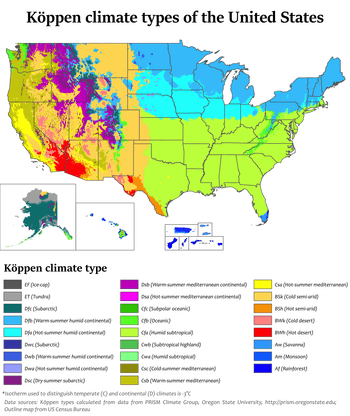
The Rocky Mountains, west of the Great Plains, extend north to south across the country, peaking around 14,000 feet (4,300 m) in Colorado.[206] Farther west are the rocky Great Basin and deserts such as the Chihuahua and Mojave.[207] The Sierra Nevada and Cascade mountain ranges run close to the Pacific coast, both ranges reaching altitudes higher than 14,000 feet (4,300 m). The lowest and highest points in the contiguous United States are in the state of California,[208] and only about 84 miles (135 km) apart.[209] At an elevation of 20,310 feet (6,190.5 m), Alaska's Denali is the highest peak in the country and in North America.[210] Active volcanoes are common throughout Alaska's Alexander and Aleutian Islands, and Hawaii consists of volcanic islands. The supervolcano underlying Yellowstone National Park in the Rockies is the continent's largest volcanic feature.[211]
The United States, with its large size and geographic variety, includes most climate types. To the east of the 100th meridian, the climate ranges from humid continental in the north to humid subtropical in the south.[212] The Great Plains west of the 100th meridian are semi-arid. Much of the Western mountains have an alpine climate. The climate is arid in the Great Basin, desert in the Southwest, Mediterranean in coastal California, and oceanic in coastal Oregon and Washington and southern Alaska. Most of Alaska is subarctic or polar. Hawaii and the southern tip of Florida are tropical, as well as its territories in the Caribbean and the Pacific.[213] States bordering the Gulf of Mexico are prone to hurricanes, and most of the world's tornadoes occur in the country, mainly in Tornado Alley areas in the Midwest and South.[214] Overall, the United States has the world's most violent weather, receiving more high-impact extreme weather incidents than any other country in the world.[215]
Wildlife and conservation

The U.S. ecology is megadiverse: about 17,000 species of vascular plants occur in the contiguous United States and Alaska, and more than 1,800 species of flowering plants are found in Hawaii, few of which occur on the mainland.[217] The United States is home to 428 mammal species, 784 bird species, 311 reptile species, and 295 amphibian species,[218] as well as about 91,000 insect species.[219]
There are 62 national parks and hundreds of other federally managed parks, forests, and wilderness areas.[220] Altogether, the government owns about 28% of the country's land area,[221] mostly in the western states.[222] Most of this land is protected, though some is leased for oil and gas drilling, mining, logging, or cattle ranching, and about .86% is used for military purposes.[223][224]
Environmental issues include debates on oil and nuclear energy, dealing with air and water pollution, the economic costs of protecting wildlife, logging and deforestation,[225][226] and international responses to global warming.[227][228] The most prominent environmental agency is the Environmental Protection Agency (EPA), created by presidential order in 1970.[229] The idea of wilderness has shaped the management of public lands since 1964, with the Wilderness Act.[230] The Endangered Species Act of 1973 is intended to protect threatened and endangered species and their habitats, which are monitored by the United States Fish and Wildlife Service.[231]
Demographics
Population
| Historical population | |||
|---|---|---|---|
| Census | Pop. | %± | |
| 1790 | 3,929,214 | — | |
| 1800 | 5,308,483 | 35.1% | |
| 1810 | 7,239,881 | 36.4% | |
| 1820 | 9,638,453 | 33.1% | |
| 1830 | 12,866,020 | 33.5% | |
| 1840 | 17,069,453 | 32.7% | |
| 1850 | 23,191,876 | 35.9% | |
| 1860 | 31,443,321 | 35.6% | |
| 1870 | 38,558,371 | 22.6% | |
| 1880 | 50,189,209 | 30.2% | |
| 1890 | 62,979,766 | 25.5% | |
| 1900 | 76,212,168 | 21.0% | |
| 1910 | 92,228,496 | 21.0% | |
| 1920 | 106,021,537 | 15.0% | |
| 1930 | 123,202,624 | 16.2% | |
| 1940 | 132,164,569 | 7.3% | |
| 1950 | 151,325,798 | 14.5% | |
| 1960 | 179,323,175 | 18.5% | |
| 1970 | 203,211,926 | 13.3% | |
| 1980 | 226,545,805 | 11.5% | |
| 1990 | 248,709,873 | 9.8% | |
| 2000 | 281,421,906 | 13.2% | |
| 2010 | 308,745,538 | 9.7% | |
| Est. 2019[232] | 328,239,523 | 6.3% | |
| 1610–1780 population data.[233] Note that the census numbers do not include Native Americans until 1860.[234] | |||
.svg.png)
The U.S. Census Bureau officially estimated the country's population to be 328,239,523 as of July 1, 2019.[232] In addition, the Census Bureau provides a continuously updated U.S. Population Clock that approximates the latest population of the 50 states and District of Columbia based on the Bureau's most recent demographic trends.[235] According to the clock, on May 23, 2020, the U.S. population exceeded 329 million residents, with a net gain of one person every 19 seconds, or about 4,547 people per day. The United States is the third most populous nation in the world, after China and India. In 2018 the median age of the United States population was 38.1 years.[236]
In 2018, there were almost 90 million immigrants and U.S.-born children of immigrants (second-generation Americans) in the United States, accounting for 28% of the overall U.S. population.[237] The United States has a very diverse population; 37 ancestry groups have more than one million members.[238] White Americans of European ancestry (mostly German, Irish, Mexican, and English),[239] form the largest racial group, at 73.1% of the population; African Americans constitute the nation's largest racial minority and third-largest ancestry group, and are around 13% of the total U.S. population.[238] Asian Americans are the country's second-largest racial minority (the three largest Asian ethnic groups are Chinese, Filipino, and Indian).[238]
In 2017, out of the U.S. foreign-born population, some 45% (20.7 million) were naturalized citizens, 27% (12.3 million) were lawful permanent residents (including many eligible to become citizens), 6% (2.2 million) were temporary lawful residents, and 23% (10.5 million) were unauthorized immigrants.[240] Among current living immigrants to the U.S., the top five countries of birth are Mexico, China, India, the Philippines and El Salvador. Until 2017 and 2018, the United States led the world in refugee resettlement for decades, admitting more refugees than the rest of the world combined.[241]
About 82% of Americans live in urban areas (including suburbs);[203] about half of those reside in cities with populations over 50,000.[242] In 2008, 273 incorporated municipalities had populations over 100,000, nine cities had more than one million residents, and four cities had over two million (namely New York, Los Angeles, Chicago, and Houston).[243] Estimates for the year 2018 show that 53 metropolitan areas have populations greater than one million. Many metros in the South, Southwest and West grew significantly between 2010 and 2018. The Dallas and Houston metros increased by more than a million people, while the Washington, D.C., Miami, Atlanta, and Phoenix metros all grew by more than 500,000 people.
Language
English (specifically, American English) is the de facto national language of the United States. Although there is no official language at the federal level, some laws—such as U.S. naturalization requirements—standardize English. In 2010, about 230 million, or 80% of the population aged five years and older, spoke only English at home. 12% of the population speaks Spanish at home, making it the second most common language. Spanish is also the most widely taught second language.[244][245]
Both Hawaiian and English are official languages in Hawaii.[246] In addition to English, Alaska recognizes twenty official Native languages,[247][lower-alpha 10] and South Dakota recognizes Sioux.[248] While neither has an official language, New Mexico has laws providing for the use of both English and Spanish, as Louisiana does for English and French.[249] Other states, such as California, mandate the publication of Spanish versions of certain government documents including court forms.[250]
Several insular territories grant official recognition to their native languages, along with English: Samoan[251] is officially recognized by American Samoa and Chamorro[252] is an official language of Guam. Both Carolinian and Chamorro have official recognition in the Northern Mariana Islands.[253] Spanish is an official language of Puerto Rico and is more widely spoken than English there.[254]
The most widely taught foreign languages in the United States, in terms of enrollment numbers from kindergarten through university undergraduate education, are Spanish (around 7.2 million students), French (1.5 million), and German (500,000). Other commonly taught languages include Latin, Japanese, ASL, Italian, and Chinese.[255][256] 18% of all Americans claim to speak both English and another language.[257]
| Language | Percent of population | Number of speakers | Number who speak English very well | Number who speak English less than very well |
|---|---|---|---|---|
| English (only) | ~80% | 237,810,023 | N/A | N/A |
| Spanish (including Spanish Creole but excluding residents of Puerto Rico) | 13% | 40,489,813 | 23,899,421 | 16,590,392 |
| Chinese (all varieties, including Mandarin and Cantonese) | 1.0% | 3,372,930 | 1,518,619 | 1,854,311 |
| Tagalog (including Filipino) | 0.5% | 1,701,960 | 1,159,211 | 542,749 |
| Vietnamese | 0.4% | 1,509,993 | 634,273 | 875,720 |
| Arabic (all varieties) | 0.3% | 1,231,098 | 770,882 | 460,216 |
| French (including Patois and Cajun) | 0.3% | 1,216,668 | 965,584 | 251,087 |
| Korean | 0.2% | 1,088,788 | 505,734 | 583,054 |
Religion
Religion in the United States (2017)[260]
The First Amendment of the U.S. Constitution guarantees the free exercise of religion and forbids Congress from passing laws respecting its establishment.
In a 2014 survey, 70.6% of adults in the United States identified themselves as Christians;[261] Protestants accounted for 46.5%, while Roman Catholics, at 20.8%, formed the largest single Christian group.[262] In 2014, 5.9% of the U.S. adult population claimed a non-Christian religion.[263] These include Judaism (1.9%), Islam (0.9%), Hinduism (0.7%), and Buddhism (0.7%).[263] The survey also reported that 22.8% of Americans described themselves as agnostic, atheist or simply having no religion—up from 8.2% in 1990.[262][264][265]
Protestantism is the largest Christian religious grouping in the United States, accounting for almost half of all Americans. Baptists collectively form the largest branch of Protestantism at 15.4%,[266] and the Southern Baptist Convention is the largest individual Protestant denomination at 5.3% of the U.S. population.[266] Apart from Baptists, other Protestant categories include nondenominational Protestants, Methodists, Pentecostals, unspecified Protestants, Lutherans, Presbyterians, Congregationalists, other Reformed, Episcopalians/Anglicans, Quakers, Adventists, Holiness, Christian fundamentalists, Anabaptists, Pietists, and multiple others.[266]
The Bible Belt is an informal term for a region in the Southern United States in which socially conservative evangelical Protestantism is a significant part of the culture and Christian church attendance across the denominations is generally higher than the nation's average. By contrast, religion plays the least important role in New England and in the Western United States.[267]
Family structure
As of 2018, 52% of Americans age 15 and over were married, 6% were widowed, 10% were divorced, and 32% had never been married.[268] Women now work mostly outside the home and receive the majority of bachelor's degrees.[269]
The U.S. teenage pregnancy rate is 26.5 per 1,000 women. The rate has declined by 57% since 1991.[270] Abortion is legal throughout the country. Abortion rates, currently 241 per 1,000 live births and 15 per 1,000 women aged 15–44, are falling but remain higher than most Western nations.[271] In 2013, the average age at first birth was 26 and 41% of births were to unmarried women.[272]
The total fertility rate in 2016 was 1820.5 births per 1000 women.[273] Adoption in the United States is common and relatively easy from a legal point of view (compared to other Western countries).[274] As of 2001, with more than 127,000 adoptions, the U.S. accounted for nearly half of the total number of adoptions worldwide.[275] Same-sex marriage is legal nationwide, and it is legal for same-sex couples to adopt. Polygamy is illegal throughout the U.S.[276]
In 2019, the U.S. had the world's highest rate of children living in single-parent households.[277]
Health

The United States had a life expectancy of 78.6 years at birth in 2017, which was the third year of declines in life expectancy following decades of continuous increase. The recent decline, primarily among the age group 25 to 64, is largely due to sharp increases in the drug overdose and suicide rates; the country has one of the highest suicide rates among wealthy countries.[278][279] Life expectancy was highest among Asians and Hispanics and lowest among blacks.[280][281] According to CDC and Census Bureau data, deaths from suicide, alcohol and drug overdoses hit record highs in 2017.[282]
Increasing obesity in the United States and health improvements elsewhere contributed to lowering the country's rank in life expectancy from 11th in the world in 1987, to 42nd in 2007, and as of 2017 the country had the lowest life expectancy among Japan, Canada, Australia, the UK, and seven countries of western Europe.[283][284] Obesity rates have more than doubled in the last 30 years and are the highest in the industrialized world.[285][286] Approximately one-third of the adult population is obese and an additional third is overweight.[287] Obesity-related type 2 diabetes is considered epidemic by health care professionals.[288]
In 2010, coronary artery disease, lung cancer, stroke, chronic obstructive pulmonary diseases, and traffic accidents caused the most years of life lost in the U.S. Low back pain, depression, musculoskeletal disorders, neck pain, and anxiety caused the most years lost to disability. The most harmful risk factors were poor diet, tobacco smoking, obesity, high blood pressure, high blood sugar, physical inactivity, and alcohol use. Alzheimer's disease, drug abuse, kidney disease, cancer, and falls caused the most additional years of life lost over their age-adjusted 1990 per-capita rates.[289] U.S. teenage pregnancy and abortion rates are substantially higher than in other Western nations, especially among blacks and Hispanics.[290]
Health-care coverage in the United States is a combination of public and private efforts and is not universal. In 2017, 12.2% of the population did not carry health insurance.[291] The subject of uninsured and underinsured Americans is a major political issue.[292][293] Federal legislation, passed in early 2010, roughly halved the uninsured share of the population, though the bill and its ultimate effect are issues of controversy.[294][295] The U.S. health-care system far outspends any other nation, measured both in per capita spending and as percentage of GDP.[296] At the same time, the U.S. is a global leader in medical innovation.[297]
Education

American public education is operated by state and local governments, regulated by the United States Department of Education through restrictions on federal grants. In most states, children are required to attend school from the age of six or seven (generally, kindergarten or first grade) until they turn 18 (generally bringing them through twelfth grade, the end of high school); some states allow students to leave school at 16 or 17.[298]
About 12% of children are enrolled in parochial or nonsectarian private schools. Just over 2% of children are homeschooled.[299] The U.S. spends more on education per student than any nation in the world, spending more than $11,000 per elementary student in 2010 and more than $12,000 per high school student.[300] Some 80% of U.S. college students attend public universities.[301]
Of Americans 25 and older, 84.6% graduated from high school, 52.6% attended some college, 27.2% earned a bachelor's degree, and 9.6% earned graduate degrees.[302] The basic literacy rate is approximately 99%.[203][303] The United Nations assigns the United States an Education Index of 0.97, tying it for 12th in the world.[304]
The United States has many private and public institutions of higher education. The majority of the world's top universities, as listed by various ranking organizations, are in the U.S.[305][306][307] There are also local community colleges with generally more open admission policies, shorter academic programs, and lower tuition.
In 2018, U21, a network of research-intensive universities, ranked the United States first in the world for breadth and quality of higher education, and 15th when GDP was a factor.[308] As for public expenditures on higher education, the U.S. trails some other OECD nations but spends more per student than the OECD average, and more than all nations in combined public and private spending.[300][309] As of 2018, student loan debt exceeded 1.5 trillion dollars.[310][311]
Government and politics

The United States is a federal republic of 50 states, a federal district, five territories and several uninhabited island possessions.[312][313][314] It is the world's oldest surviving federation. It is a federal republic and a representative democracy, "in which majority rule is tempered by minority rights protected by law."[315] For 2018, the U.S. ranked 25th on the Democracy Index.[316] On Transparency International's 2019 Corruption Perceptions Index its public sector position deteriorated from a score of 76 in 2015 to 69 in 2019.[317]
In the American federalist system, citizens are usually subject to three levels of government: federal, state, and local. The local government's duties are commonly split between county and municipal governments. In almost all cases, executive and legislative officials are elected by a plurality vote of citizens by district.
The government is regulated by a system of checks and balances defined by the U.S. Constitution, which serves as the country's supreme legal document.[318] The original text of the Constitution establishes the structure and responsibilities of the federal government and its relationship with the individual states. Article One protects the right to the "great writ" of habeas corpus. The Constitution has been amended 27 times;[319] the first ten amendments, which make up the Bill of Rights, and the Fourteenth Amendment form the central basis of Americans' individual rights. All laws and governmental procedures are subject to judicial review and any law ruled by the courts to be in violation of the Constitution is voided. The principle of judicial review, not explicitly mentioned in the Constitution, was established by the Supreme Court in Marbury v. Madison (1803)[320] in a decision handed down by Chief Justice John Marshall.[321]
The federal government comprises three branches:
- Legislative: The bicameral Congress, made up of the Senate and the House of Representatives, makes federal law, declares war, approves treaties, has the power of the purse,[322] and has the power of impeachment, by which it can remove sitting members of the government.[323]
- Executive: The president is the commander-in-chief of the military, can veto legislative bills before they become law (subject to Congressional override), and appoints the members of the Cabinet (subject to Senate approval) and other officers, who administer and enforce federal laws and policies.[324]
- Judicial: The Supreme Court and lower federal courts, whose judges are appointed by the president with Senate approval, interpret laws and overturn those they find unconstitutional.[325]
The House of Representatives has 435 voting members, each representing a congressional district for a two-year term. House seats are apportioned among the states by population. Each state then draws single-member districts to conform with the census apportionment. The District of Columbia and the five major U.S. territories each have one member of Congress—these members are not allowed to vote.[326]
The Senate has 100 members with each state having two senators, elected at-large to six-year terms; one-third of Senate seats are up for election every two years. The District of Columbia and the five major U.S. territories do not have senators.[326] The president serves a four-year term and may be elected to the office no more than twice. The president is not elected by direct vote, but by an indirect electoral college system in which the determining votes are apportioned to the states and the District of Columbia.[327] The Supreme Court, led by the chief justice of the United States, has nine members, who serve for life.[328]
The state governments are structured in a roughly similar fashion, though Nebraska has a unicameral legislature.[329] The governor (chief executive) of each state is directly elected. Some state judges and cabinet officers are appointed by the governors of the respective states, while others are elected by popular vote.
Political divisions
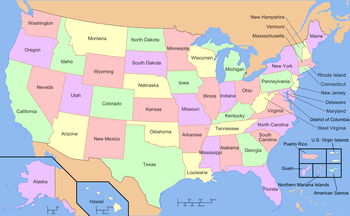
The 50 states are the principal administrative divisions in the country. These are subdivided into counties or county equivalents and further divided into municipalities. The District of Columbia is a federal district that contains the capital of the United States, Washington, D.C.[330] The states and the District of Columbia choose the president of the United States. Each state has presidential electors equal to the number of their representatives and senators in Congress; the District of Columbia has three (because of the 23rd Amendment).[331] Territories of the United States such as Puerto Rico do not have presidential electors, and so people in those territories cannot vote for the president.[326]
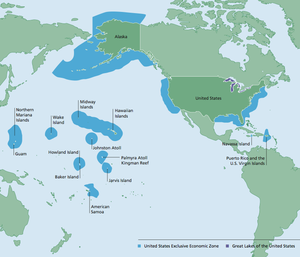
The United States also observes tribal sovereignty of the American Indian nations to a limited degree, as it does with the states' sovereignty. American Indians are U.S. citizens and tribal lands are subject to the jurisdiction of the U.S. Congress and the federal courts. Like the states they have a great deal of autonomy, but also like the states, tribes are not allowed to make war, engage in their own foreign relations, or print and issue currency.[332]
Citizenship is granted at birth in all states, the District of Columbia, and all major U.S. territories except American Samoa.[333][334][lower-alpha 12]
Parties and elections
.jpg)
.jpg)
The United States has operated under a two-party system for most of its history.[337] For elective offices at most levels, state-administered primary elections choose the major party nominees for subsequent general elections. Since the general election of 1856, the major parties have been the Democratic Party, founded in 1824, and the Republican Party, founded in 1854. Since the Civil War, only one third-party presidential candidate—former president Theodore Roosevelt, running as a Progressive in 1912—has won as much as 20% of the popular vote. The president and vice president are elected by the Electoral College.[338]
In American political culture, the center-right Republican Party is considered "conservative" and the center-left Democratic Party is considered "liberal."[339][340] The states of the Northeast and West Coast and some of the Great Lakes states, known as "blue states," are relatively liberal. The "red states" of the South and parts of the Great Plains and Rocky Mountains are relatively conservative.
Republican Donald Trump, the winner of the 2016 presidential election, is serving as the 45th president of the United States.[341] Leadership in the Senate includes Republican vice president Mike Pence, Republican president pro tempore Chuck Grassley, Majority Leader Mitch McConnell, and Minority Leader Chuck Schumer.[342] Leadership in the House includes Speaker of the House Nancy Pelosi, Majority Leader Steny Hoyer, and Minority Leader Kevin McCarthy.[343]
.jpg)
In the 116th United States Congress, the House of Representatives is controlled by the Democratic Party and the Senate is controlled by the Republican Party, giving the U.S. a split Congress. The Senate consists of 53 Republicans and 45 Democrats with two Independents who caucus with the Democrats; the House consists of 233 Democrats, 196 Republicans, and 1 Libertarian.[344] Of state governors, there are 26 Republicans and 24 Democrats. Among the D.C. mayor and the five territorial governors, there are two Republicans, one Democrat, one New Progressive, and two Independents.[345]
Foreign relations
.jpg)
The United States has an established structure of foreign relations. It is a permanent member of the United Nations Security Council. New York City is home to the United Nations Headquarters. Almost all countries have embassies in Washington, D.C., and many have consulates around the country. Likewise, nearly all nations host American diplomatic missions. However, Iran, North Korea, Bhutan, and the Republic of China (Taiwan) do not have formal diplomatic relations with the United States (although the U.S. still maintains unofficial relations with Bhutan and Taiwan).[346] It is a member of the G7,[347] G20, and OECD.
The United States has a "Special Relationship" with the United Kingdom[348] and strong ties with India, Canada,[349] Australia,[350] New Zealand,[351] the Philippines,[352] Japan,[353] South Korea,[354] Israel,[355] and several European Union countries, including France, Italy, Germany, Spain and Poland.[356] It works closely with fellow NATO members on military and security issues and with its neighbors through the Organization of American States and free trade agreements such as the trilateral North American Free Trade Agreement with Canada and Mexico. Colombia is traditionally considered by the United States as its most loyal ally in South America.[357][358]
The U.S. exercises full international defense authority and responsibility for Micronesia, the Marshall Islands and Palau through the Compact of Free Association.[359]
Government finance

Taxation in the United States is levied at the federal, state, and local government levels. This includes taxes on income, payroll, property, sales, imports, estates, and gifts, as well as various fees. Taxation in the United States is based on citizenship, not residency.[360] Both non-resident citizens and Green Card holders living abroad are taxed on their income irrespective of where they live or where their income is earned. The United States is one of the only countries in the world to do so.[361]
In 2010 taxes collected by federal, state and municipal governments amounted to 24.8% of GDP.[362] Based on CBO estimates,[363] under 2013 tax law the top 1% will be paying the highest average tax rates since 1979, while other income groups will remain at historic lows.[364] For 2018, the effective tax rate for the wealthiest 400 households was 23%, compared to 24.2% for the bottom half of U.S. households.[365]
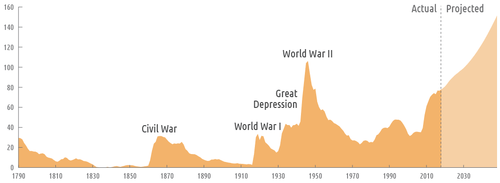
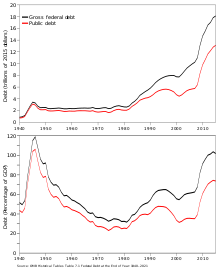
During fiscal year 2012, the federal government spent $3.54 trillion on a budget or cash basis, down $60 billion or 1.7% vs. fiscal year 2011 spending of $3.60 trillion. Major categories of fiscal year 2012 spending included: Medicare & Medicaid (23%), Social Security (22%), Defense Department (19%), non-defense discretionary (17%), other mandatory (13%) and interest (6%).[367]
The total national debt of the United States in the United States was $18.527 trillion (106% of the GDP) in 2014.[368][lower-alpha 13] The United States has the largest external debt in the world[372] and the 34th largest government debt as a % of GDP in the world.[373]
Military
_transits_the_Atlantic_Ocean.jpg)
The president is the commander-in-chief of the country's armed forces and appoints its leaders, the Secretary of Defense and the Joint Chiefs of Staff. The United States Department of Defense administers the armed forces, including the Army, Marine Corps, Navy, Air Force, and Space Force. The Coast Guard is run by the Department of Homeland Security in peacetime and by the Department of the Navy during times of war. In 2008, the armed forces had 1.4 million personnel on active duty. The Reserves and National Guard brought the total number of troops to 2.3 million. The Department of Defense also employed about 700,000 civilians, not including contractors.[374]
Military service is voluntary, though conscription may occur in wartime through the Selective Service System.[375] American forces can be rapidly deployed by the Air Force's large fleet of transport aircraft, the Navy's 11 active aircraft carriers, and Marine expeditionary units at sea with the Navy's Atlantic and Pacific fleets. The military operates 865 bases and facilities abroad,[376] and maintains deployments greater than 100 active duty personnel in 25 foreign countries.[377]
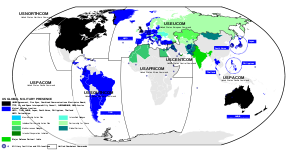
The military budget of the United States in 2011 was more than $700 billion, 41% of global military spending. At 4.7% of GDP, the rate was the second-highest among the top 15 military spenders, after Saudi Arabia.[378] Defense spending plays a major role in science and technology investment, with roughly half of U.S. federal research and development funded by the Department of Defense.[379] Defense's share of the overall U.S. economy has generally declined in recent decades, from Cold War peaks of 14.2% of GDP in 1953 and 69.5% of federal outlays in 1954 to 4.7% of GDP and 18.8% of federal outlays in 2011.[380]
The country is one of the five recognized nuclear weapons states and possesses the second largest stockpile of nuclear weapons in the world.[381] More than 90% of the world's 14,000 nuclear weapons are owned by Russia and the United States.[382]
Law enforcement and crime
Law enforcement in the United States is primarily the responsibility of local police departments and sheriff's offices, with state police providing broader services. Federal agencies such as the Federal Bureau of Investigation (FBI) and the U.S. Marshals Service have specialized duties, including protecting civil rights, national security and enforcing U.S. federal courts' rulings and federal laws.[383] State courts conduct most criminal trials while federal courts handle certain designated crimes as well as certain appeals from the state criminal courts.
A cross-sectional analysis of the World Health Organization Mortality Database from 2010 showed that United States "homicide rates were 7.0 times higher than in other high-income countries, driven by a gun homicide rate that was 25.2 times higher."[384] In 2016, the US murder rate was 5.4 per 100,000.[385] Gun ownership rights, guaranteed by the Second Amendment, continue to be the subject of contention.
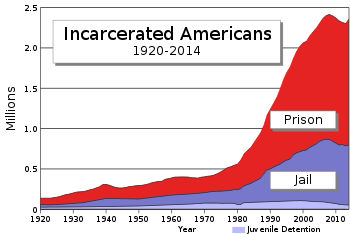
The United States has the highest documented incarceration rate and largest prison population in the world.[386] As of 2020, the Prison Policy Initiative reported that there were some 2.3 million people incarcerated.[387] The imprisonment rate for all prisoners sentenced to more than a year in state or federal facilities is 478 per 100,000 in 2013.[388] According to the Federal Bureau of Prisons, the majority of inmates held in federal prisons are convicted of drug offenses.[389] About 9% of prisoners are held in privatized prisons.[387] The practice of privately operated prisons began in the 1980s and has been a subject of contention.[390]
Capital punishment is sanctioned in the United States for certain federal and military crimes, and at the state level in 30 states.[391][392] No executions took place from 1967 to 1977, owing in part to a U.S. Supreme Court ruling striking down arbitrary imposition of the death penalty. Since the decision there have been more than 1,300 executions, a majority of these taking place in three states: Texas, Virginia, and Oklahoma.[393] Meanwhile, several states have either abolished or struck down death penalty laws. In 2019, the country had the sixth-highest number of executions in the world, following China, Iran, Saudi Arabia, Iraq, and Egypt.[394]
Economy
| Economic indicators | ||
|---|---|---|
| Nominal GDP | $20.66 trillion (Q3 2018) | [395] |
| Real GDP growth | 3.5% (Q3 2018) | [395] |
| 2.1% (2017) | [395] | |
| CPI inflation | 2.2% (November 2018) | [396] |
| Employment-to-population ratio | 60.6% (November 2018) | [397] |
| Unemployment | 3.7% (November 2018) | [398] |
| Labor force participation rate | 62.9% (November 2018) | [399] |
| Total public debt | $21.85 trillion (November 2018) | [400] |
| Household net worth | $109.0 trillion (Q3 2018) | [401] |
According to the International Monetary Fund, the U.S. GDP of $16.8 trillion constitutes 24% of the gross world product at market exchange rates and over 19% of the gross world product at purchasing power parity (PPP).[402] The United States is the largest importer of goods and second-largest exporter, though exports per capita are relatively low. In 2010, the total U.S. trade deficit was $635 billion.[403] Canada, China, Mexico, Japan, and Germany are its top trading partners.[404]
From 1983 to 2008, U.S. real compounded annual GDP growth was 3.3%, compared to a 2.3% weighted average for the rest of the G7.[405] The country ranks ninth in the world in nominal GDP per capita[406] and sixth in GDP per capita at PPP.[402] The U.S. dollar is the world's primary reserve currency.[407]
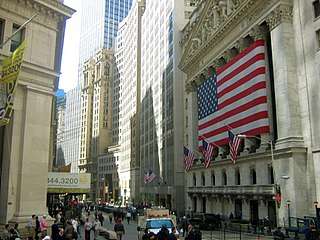
In 2009, the private sector was estimated to constitute 86.4% of the economy.[410] While its economy has reached a postindustrial level of development, the United States remains an industrial power.[411] Consumer spending comprised 68% of the U.S. economy in 2015.[412] In August 2010, the American labor force consisted of 154.1 million people (50%). With 21.2 million people, government is the leading field of employment. The largest private employment sector is health care and social assistance, with 16.4 million people. It has a smaller welfare state and redistributes less income through government action than most European nations.[413]
The United States is the only advanced economy that does not guarantee its workers paid vacation[414] and is one of a few countries in the world without paid family leave as a legal right.[415] While federal law does not require sick leave, it is a common benefit for government workers and full-time employees at corporations.[416] 74% of full-time American workers get paid sick leave, according to the Bureau of Labor Statistics, although only 24% of part-time workers get the same benefits.[416] In 2009, the United States had the third-highest workforce productivity per person in the world, behind Luxembourg and Norway. It was fourth in productivity per hour, behind those two countries and the Netherlands.[417]
Science and technology
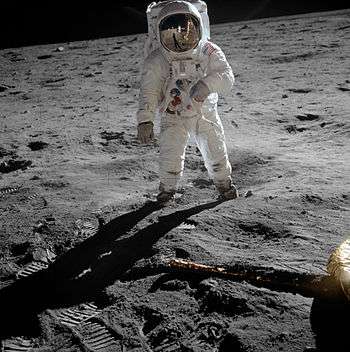
The United States has been a leader in technological innovation since the late 19th century and scientific research since the mid-20th century. Methods for producing interchangeable parts were developed by the U.S. War Department by the Federal Armories during the first half of the 19th century. This technology, along with the establishment of a machine tool industry, enabled the U.S. to have large-scale manufacturing of sewing machines, bicycles, and other items in the late 19th century and became known as the American system of manufacturing. Factory electrification in the early 20th century and introduction of the assembly line and other labor-saving techniques created the system of mass production.[418] In the 21st century, approximately two-thirds of research and development funding comes from the private sector.[419] The United States leads the world in scientific research papers and impact factor.[420][421]
In 1876, Alexander Graham Bell was awarded the first U.S. patent for the telephone. Thomas Edison's research laboratory, one of the first of its kind, developed the phonograph, the first long-lasting light bulb, and the first viable movie camera.[422] The latter led to emergence of the worldwide entertainment industry. In the early 20th century, the automobile companies of Ransom E. Olds and Henry Ford popularized the assembly line. The Wright brothers, in 1903, made the first sustained and controlled heavier-than-air powered flight.[423]
The rise of fascism and Nazism in the 1920s and 30s led many European scientists, including Albert Einstein, Enrico Fermi, and John von Neumann, to immigrate to the United States.[424] During World War II, the Manhattan Project developed nuclear weapons, ushering in the Atomic Age, while the Space Race produced rapid advances in rocketry, materials science, and aeronautics.[425][426]
The invention of the transistor in the 1950s, a key active component in practically all modern electronics, led to many technological developments and a significant expansion of the U.S. technology industry.[427] This, in turn, led to the establishment of many new technology companies and regions around the country such as Silicon Valley in California. Advancements by American microprocessor companies such as Advanced Micro Devices (AMD), and Intel along with both computer software and hardware companies that include Adobe Systems, Apple Inc., IBM, Microsoft, and Sun Microsystems created and popularized the personal computer. The ARPANET was developed in the 1960s to meet Defense Department requirements, and became the first of a series of networks which evolved into the Internet.[428]
Income, poverty and wealth
Accounting for 4.24% of the global population, Americans collectively possess 29.4% of the world's total wealth, and Americans make up roughly half of the world's population of millionaires.[429] The Global Food Security Index ranked the U.S. number one for food affordability and overall food security in March 2013.[430] Americans on average have more than twice as much living space per dwelling and per person as European Union residents, and more than every EU nation.[431] For 2017 the United Nations Development Programme ranked the United States 13th among 189 countries in its Human Development Index and 25th among 151 countries in its inequality-adjusted HDI (IHDI).[432]
Wealth, like income and taxes, is highly concentrated; the richest 10% of the adult population possess 72% of the country's household wealth, while the bottom half claim only 2%.[433] According to a September 2017 report by the Federal Reserve, the top 1% controlled 38.6% of the country's wealth in 2016.[434] According to a 2018 study by the OECD, the United States has a larger percentage of low-income workers than almost any other developed nation. This is largely because at-risk workers get almost no government support and are further set back by a very weak collective bargaining system.[435] The top one percent of income-earners accounted for 52 percent of the income gains from 2009 to 2015, where income is defined as market income excluding government transfers.[436] In 2018, U.S. income inequality reached the highest level ever recorded by the Census Bureau.[437]
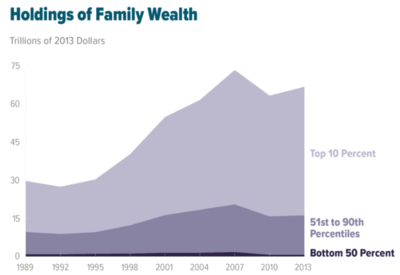
After years of stagnation, median household income reached a record high in 2016 following two consecutive years of record growth. Income inequality remains at record highs however, with the top fifth of earners taking home more than half of all overall income.[439] The rise in the share of total annual income received by the top one percent, which has more than doubled from nine percent in 1976 to 20 percent in 2011, has significantly affected income inequality,[440] leaving the United States with one of the widest income distributions among OECD nations.[441] The extent and relevance of income inequality is a matter of debate.[442][443][444]
Between June 2007 and November 2008, the global recession led to falling asset prices around the world. Assets owned by Americans lost about a quarter of their value.[445] Since peaking in the second quarter of 2007, household wealth was down $14 trillion, but has since increased $14 trillion over 2006 levels.[446] At the end of 2014, household debt amounted to $11.8 trillion,[447] down from $13.8 trillion at the end of 2008.[448]
There were about 578,424 sheltered and unsheltered homeless persons in the US in January 2014, with almost two-thirds staying in an emergency shelter or transitional housing program.[449] In 2011, 16.7 million children lived in food-insecure households, about 35% more than 2007 levels, though only 1.1% of U.S. children, or 845,000, saw reduced food intake or disrupted eating patterns at some point during the year, and most cases were not chronic.[450] As of June 2018, 40 million people, roughly 12.7% of the U.S. population, were living in poverty, with 18.5 million of those living in deep poverty (a family income below one-half of the poverty threshold) and over five million live "in 'Third World' conditions." In 2016, 13.3 million children were living in poverty, which made up 32.6% of the impoverished population.[451] In 2017, the U.S. state or territory with the lowest poverty rate was New Hampshire (7.6%), and the one with the highest was American Samoa (65%).[452][453][454]
Infrastructure
Transportation
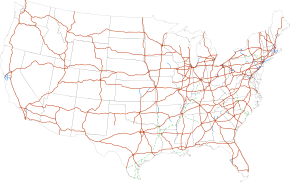
Personal transportation is dominated by automobiles, which operate on a network of 4 million miles (6.4 million kilometers) of public roads.[456] The United States has the world's second-largest automobile market,[457] and has the highest rate of per-capita vehicle ownership in the world, with 765 vehicles per 1,000 Americans (1996).[458] In 2017, there were 255,009,283 non-two wheel motor vehicles, or about 910 vehicles per 1,000 people.[459]
The civil airline industry is entirely privately owned and has been largely deregulated since 1978, while most major airports are publicly owned.[460] The three largest airlines in the world by passengers carried are US-based; American Airlines is number one after its 2013 acquisition by US Airways.[461] Of the world's 50 busiest passenger airports, 16 are in the United States, including the busiest, Hartsfield–Jackson Atlanta International Airport.[462]
Energy
The United States energy market is about 29,000 terawatt hours per year.[463] In 2005, 40% of this energy came from petroleum, 23% from coal, and 22% from natural gas. The remainder was supplied by nuclear and renewable energy sources.[464]
Since 2007, the total greenhouse gas emissions by the United States are the second highest by country, exceeded only by China.[465] The United States has historically been the world's largest producer of greenhouse gases, and greenhouse gas emissions per capita remain high.[466]
Culture
The United States is home to many cultures and a wide variety of ethnic groups, traditions, and values.[468][469] Aside from the Native American, Native Hawaiian, and Native Alaskan populations, nearly all Americans or their ancestors settled or immigrated within the past five centuries.[470] Mainstream American culture is a Western culture largely derived from the traditions of European immigrants with influences from many other sources, such as traditions brought by slaves from Africa.[468][471] More recent immigration from Asia and especially Latin America has added to a cultural mix that has been described as both a homogenizing melting pot, and a heterogeneous salad bowl in which immigrants and their descendants retain distinctive cultural characteristics.[468]
Americans have traditionally been characterized by a strong work ethic, competitiveness, and individualism,[472] as well as a unifying belief in an "American creed" emphasizing liberty, equality, private property, democracy, rule of law, and a preference for limited government.[473] Americans are extremely charitable by global standards. According to a 2006 British study, Americans gave 1.67% of GDP to charity, more than any other nation studied.[474][475][476]
The American Dream, or the perception that Americans enjoy high social mobility, plays a key role in attracting immigrants.[477] Whether this perception is accurate has been a topic of debate.[478][479][480][481][405][482] While mainstream culture holds that the United States is a classless society,[483] scholars identify significant differences between the country's social classes, affecting socialization, language, and values.[484] While Americans tend to greatly value socioeconomic achievement, being ordinary or average is also generally seen as a positive attribute.[485]
Literature, philosophy, and visual art
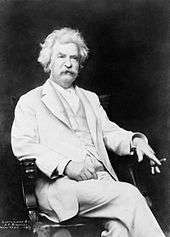
In the 18th and early 19th centuries, American art and literature took most of its cues from Europe. Writers such as Washington Irving, Nathaniel Hawthorne, Edgar Allan Poe, and Henry David Thoreau established a distinctive American literary voice by the middle of the 19th century. Mark Twain and poet Walt Whitman were major figures in the century's second half; Emily Dickinson, virtually unknown during her lifetime, is now recognized as an essential American poet.[486] A work seen as capturing fundamental aspects of the national experience and character—such as Herman Melville's Moby-Dick (1851), Twain's The Adventures of Huckleberry Finn (1885), F. Scott Fitzgerald's The Great Gatsby (1925) and Harper Lee's To Kill a Mockingbird (1960)—may be dubbed the "Great American Novel."[487]
Twelve U.S. citizens have won the Nobel Prize in Literature, most recently Bob Dylan in 2016. William Faulkner, Ernest Hemingway and John Steinbeck are often named among the most influential writers of the 20th century.[488] Popular literary genres such as the Western and hardboiled crime fiction developed in the United States. The Beat Generation writers opened up new literary approaches, as have postmodernist authors such as John Barth, Thomas Pynchon, and Don DeLillo.[489]
The transcendentalists, led by Thoreau and Ralph Waldo Emerson, established the first major American philosophical movement. After the Civil War, Charles Sanders Peirce and then William James and John Dewey were leaders in the development of pragmatism. In the 20th century, the work of W. V. O. Quine and Richard Rorty, and later Noam Chomsky, brought analytic philosophy to the fore of American philosophical academia. John Rawls and Robert Nozick also led a revival of political philosophy.
In the visual arts, the Hudson River School was a mid-19th-century movement in the tradition of European naturalism. The 1913 Armory Show in New York City, an exhibition of European modernist art, shocked the public and transformed the U.S. art scene.[490] Georgia O'Keeffe, Marsden Hartley, and others experimented with new, individualistic styles. Major artistic movements such as the abstract expressionism of Jackson Pollock and Willem de Kooning and the pop art of Andy Warhol and Roy Lichtenstein developed largely in the United States. The tide of modernism and then postmodernism has brought fame to American architects such as Frank Lloyd Wright, Philip Johnson, and Frank Gehry.[491] Americans have long been important in the modern artistic medium of photography, with major photographers including Alfred Stieglitz, Edward Steichen, Edward Weston, and Ansel Adams.[492]
Food
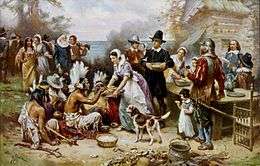
Mainstream American cuisine is similar to that in other Western countries. Wheat is the primary cereal grain with about three-quarters of grain products made of wheat flour[493] and many dishes use indigenous ingredients, such as turkey, venison, potatoes, sweet potatoes, corn, squash, and maple syrup which were consumed by Native Americans and early European settlers.[494] These homegrown foods are part of a shared national menu on one of America's most popular holidays, Thanksgiving, when some Americans make traditional foods to celebrate the occasion.[495]
The American fast food industry, the world's largest,[496] pioneered the drive-through format in the 1940s.[497] Characteristic dishes such as apple pie, fried chicken, pizza, hamburgers, and hot dogs derive from the recipes of various immigrants. French fries, Mexican dishes such as burritos and tacos, and pasta dishes freely adapted from Italian sources are widely consumed.[498] Americans drink three times as much coffee as tea.[499] Marketing by U.S. industries is largely responsible for making orange juice and milk ubiquitous breakfast beverages.[500][501]
Music
Although little known at the time, Charles Ives's work of the 1910s established him as the first major U.S. composer in the classical tradition, while experimentalists such as Henry Cowell and John Cage created a distinctive American approach to classical composition. Aaron Copland and George Gershwin developed a new synthesis of popular and classical music.
The rhythmic and lyrical styles of African-American music have deeply influenced American music at large, distinguishing it from European and African traditions. Elements from folk idioms such as the blues and what is now known as old-time music were adopted and transformed into popular genres with global audiences. Jazz was developed by innovators such as Louis Armstrong and Duke Ellington early in the 20th century. Country music developed in the 1920s, and rhythm and blues in the 1940s.[502]
Elvis Presley and Chuck Berry were among the mid-1950s pioneers of rock and roll. Rock bands such as Metallica, the Eagles, and Aerosmith are among the highest grossing in worldwide sales.[503][504][505] In the 1960s, Bob Dylan emerged from the folk revival to become one of America's most celebrated songwriters and James Brown led the development of funk.
More recent American creations include hip hop and house music. American pop stars such as Elvis Presley, Michael Jackson, and Madonna have become global celebrities,[502] as have contemporary musical artists such as Taylor Swift, Britney Spears, Katy Perry, Beyoncé, Jay-Z, Eminem, Kanye West, and Ariana Grande.[506]
Cinema
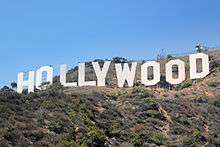
Hollywood, a northern district of Los Angeles, California, is one of the leaders in motion picture production.[507] The world's first commercial motion picture exhibition was given in New York City in 1894, using Thomas Edison's Kinetoscope.[508] Since the early 20th century, the U.S. film industry has largely been based in and around Hollywood, although in the 21st century an increasing number of films are not made there, and film companies have been subject to the forces of globalization.[509]
Director D. W. Griffith, the top American filmmaker during the silent film period, was central to the development of film grammar, and producer/entrepreneur Walt Disney was a leader in both animated film and movie merchandising.[510] Directors such as John Ford redefined the image of the American Old West, and, like others such as John Huston, broadened the possibilities of cinema with location shooting. The industry enjoyed its golden years, in what is commonly referred to as the "Golden Age of Hollywood," from the early sound period until the early 1960s,[511] with screen actors such as John Wayne and Marilyn Monroe becoming iconic figures.[512][513] In the 1970s, "New Hollywood" or the "Hollywood Renaissance"[514] was defined by grittier films influenced by French and Italian realist pictures of the post-war period.[515] In more recent times, directors such as Steven Spielberg, George Lucas and James Cameron have gained renown for their blockbuster films, often characterized by high production costs and earnings.
Notable films topping the American Film Institute's AFI 100 list include Orson Welles's Citizen Kane (1941), which is frequently cited as the greatest film of all time,[516][517] Casablanca (1942), The Godfather (1972), Gone with the Wind (1939), Lawrence of Arabia (1962), The Wizard of Oz (1939), The Graduate (1967), On the Waterfront (1954), Schindler's List (1993), Singin' in the Rain (1952), It's a Wonderful Life (1946) and Sunset Boulevard (1950).[518] The Academy Awards, popularly known as the Oscars, have been held annually by the Academy of Motion Picture Arts and Sciences since 1929,[519] and the Golden Globe Awards have been held annually since January 1944.[520]
Sports
American football is by several measures the most popular spectator sport;[522] the National Football League (NFL) has the highest average attendance of any sports league in the world, and the Super Bowl is watched by tens of millions globally. Baseball has been regarded as the U.S. national sport since the late 19th century, with Major League Baseball (MLB) being the top league. Basketball and ice hockey are the country's next two leading professional team sports, with the top leagues being the National Basketball Association (NBA) and the National Hockey League (NHL). College football and basketball attract large audiences.[523] In soccer, the country hosted the 1994 FIFA World Cup, the men's national soccer team qualified for ten World Cups and the women's team has won the FIFA Women's World Cup four times; Major League Soccer is the sport's highest league in the United States (featuring 23 American and three Canadian teams). The market for professional sports in the United States is roughly $69 billion, roughly 50% larger than that of all of Europe, the Middle East, and Africa combined.[524]
Eight Olympic Games have taken place in the United States. The 1904 Summer Olympics in St. Louis, Missouri were the first ever Olympic Games held outside of Europe.[525] As of 2017, the United States has won 2,522 medals at the Summer Olympic Games, more than any other country, and 305 in the Winter Olympic Games, the second most behind Norway.[526] While most major U.S. sports such as baseball and American football have evolved out of European practices, basketball, volleyball, skateboarding, and snowboarding are American inventions, some of which have become popular worldwide. Lacrosse and surfing arose from Native American and Native Hawaiian activities that predate Western contact.[527] The most watched individual sports are golf and auto racing, particularly NASCAR.[528][529]
Mass media
The four major broadcasters in the U.S. are the National Broadcasting Company (NBC), Columbia Broadcasting System (CBS), American Broadcasting Company (ABC), and Fox Broadcasting Company (FOX). The four major broadcast television networks are all commercial entities. Cable television offers hundreds of channels catering to a variety of niches.[530] Americans listen to radio programming, also largely commercial, on average just over two-and-a-half hours a day.[531]
In 1998, the number of U.S. commercial radio stations had grown to 4,793 AM stations and 5,662 FM stations. In addition, there are 1,460 public radio stations. Most of these stations are run by universities and public authorities for educational purposes and are financed by public or private funds, subscriptions, and corporate underwriting. Much public-radio broadcasting is supplied by NPR. NPR was incorporated in February 1970 under the Public Broadcasting Act of 1967; its television counterpart, PBS, was created by the same legislation. As of September 30, 2014, there are 15,433 licensed full-power radio stations in the U.S. according to the U.S. Federal Communications Commission (FCC).[532]
Well-known newspapers include The Wall Street Journal, The New York Times, and USA Today.[533] Although the cost of publishing has increased over the years, the price of newspapers has generally remained low, forcing newspapers to rely more on advertising revenue and on articles provided by a major wire service, such as the Associated Press or Reuters, for their national and world coverage. With very few exceptions, all the newspapers in the U.S. are privately owned, either by large chains such as Gannett or McClatchy, which own dozens or even hundreds of newspapers; by small chains that own a handful of papers; or in a situation that is increasingly rare, by individuals or families. Major cities often have "alternative weeklies" to complement the mainstream daily papers, such as New York City's The Village Voice or Los Angeles' LA Weekly. Major cities may also support a local business journal, trade papers relating to local industries, and papers for local ethnic and social groups. Aside from web portals and search engines, the most popular websites are Facebook, YouTube, Wikipedia, Yahoo!, eBay, Amazon, and Twitter.[534]
More than 800 publications are produced in Spanish, the second most commonly used language in the United States behind English.[535][536]
See also
- Index of United States-related articles
- Lists of U.S. state topics
- Outline of the United States
Notes
- English is the official language of 32 states; English and Hawaiian are both official languages in Hawaii, and English and 20 Indigenous languages are official in Alaska. Algonquian, Cherokee, and Sioux are among many other official languages in Native-controlled lands throughout the country. French is a de facto, but unofficial, language in Maine and Louisiana, while New Mexico law grants Spanish a special status. In five territories, English as well as one or more indigenous languages are official: Spanish in Puerto Rico, Samoan in American Samoa, Chamorro in both Guam and the Northern Mariana Islands. Carolinian is also an official language in the Northern Mariana Islands.[5][6]
- The historical and informal demonym Yankee has been applied to Americans, New Englanders, or northeasterners since the 18th century.
- Also president of the Senate.
- The Encyclopædia Britannica lists China as the world's third-largest country (after Russia and Canada) with a total area of 9,572,900 km2 (3,696,100 sq mi),[15] and the United States as fourth-largest at 9,526,468 km2 (3,678,190 sq mi). This figure for the United States is less than the one cited in the CIA World Factbook because it excludes coastal and territorial waters.[16]
The CIA World Factbook lists the United States as the third-largest country (after Russia and Canada) with total area of 9,833,517 km2 (3,796,742 sq mi),[17] and China as fourth-largest at 9,596,960 km2 (3,705,410 sq mi).[18] This figure for the United States is greater than in the Encyclopædia Britannica because it includes coastal and territorial waters. - Excludes Puerto Rico and the other unincorporated islands.
- See Time in the United States for details about laws governing time zones in the United States.
- Except the U.S. Virgin Islands.
- The five major territories are American Samoa, Guam, the Northern Mariana Islands, Puerto Rico, and the United States Virgin Islands. There are eleven smaller island areas without permanent populations: Baker Island, Howland Island, Jarvis Island, Johnston Atoll, Kingman Reef, Midway Atoll, and Palmyra Atoll. U.S. sovereignty over Bajo Nuevo Bank, Navassa Island, Serranilla Bank, and Wake Island is disputed.[14]
- Spain sent several expeditions to Alaska to assert its long-held claim over the Pacific Northwest, which dated back to the 16th century. During the decade 1785–1795 British merchants, encouraged by Sir Joseph Banks and supported by their government, made a sustained attempt to develop this trade despite Spain's claims and navigation rights. The endeavors of these merchants did not last long in the face of Spain's opposition. The challenge was also opposed by a Japanese holding obdurately to national seclusion.[92]
- Inupiaq, Siberian Yupik, Central Alaskan Yup'ik, Alutiiq, Unanga (Aleut), Denaʼina, Deg Xinag, Holikachuk, Koyukon, Upper Kuskokwim, Gwichʼin, Tanana, Upper Tanana, Tanacross, Hän, Ahtna, Eyak, Tlingit, Haida, and Tsimshian.
- Source: 2015 American Community Survey, U.S. Census Bureau. Most respondents who speak a language other than English at home also report speaking English "well" or "very well". For the language groups listed above, the strongest English-language proficiency is among speakers of German (96% report that they speak English "well" or "very well"), followed by speakers of French (93.5%), Tagalog (92.8%), Spanish (74.1%), Korean (71.5%), Chinese (70.4%), and Vietnamese (66.9%).
- People born in American Samoa are non-citizen U.S. nationals, unless one of their parents is a U.S. citizen.[334] In 2019, a court ruled that American Samoans are U.S. citizens, but the litigation is onging.[335][336]
- In January 2015, U.S. federal government debt held by the public was approximately $13 trillion, or about 72% of U.S. GDP. Intra-governmental holdings stood at $5 trillion, giving a combined total debt of $18.080 trillion.[369] By 2012, total federal debt had surpassed 100% of U.S. GDP.[370] The U.S. has a credit rating of AA+ from Standard & Poor's, AAA from Fitch, and AAA from Moody's.[371]
References
- 36 U.S.C. § 302
- "The Great Seal of the United States" (PDF). U.S. Department of State, Bureau of Public Affairs. 2003. Retrieved February 12, 2020.
- Kidder & Oppenheim 2007, p. 91.
- "uscode.house.gov". Public Law 105-225. uscode.house.gov. August 12, 1999. pp. 112 Stat. 1263. Retrieved September 10, 2017.
Section 304. "The composition by John Philip Sousa entitled 'The Stars and Stripes Forever' is the national march."
- Cobarrubias 1983, p. 195.
- García 2011, p. 167.
- "U.S. Census Bureau QuickFacts: United States". United States Census. Retrieved January 21, 2020.
- Compton's Pictured Encyclopedia and Fact-index: Ohio. 1963. p. 336.
- Areas of the 50 states and the District of Columbia but not Puerto Rico nor other island territories per "State Area Measurements and Internal Point Coordinates". Census.gov. August 2010. Retrieved March 31, 2020.
reflect base feature updates made in the MAF/TIGER database through August, 2010.
- "Annual Estimates of the Resident Population: April 1, 2010 to July 1, 2016". United States Census. Archived from the original on February 14, 2020. Retrieved July 25, 2017. The 2016 estimate is as of July 1, 2016. The 2010 census is as of April 1, 2010.
- "World Economic Outlook Database, October 2019". IMF.org. International Monetary Fund. Retrieved March 30, 2020.
- "Income inequality in America is the highest it's been since Census Bureau started tracking it, data shows". www.washingtonpost.com. The Washington Post. Retrieved July 27, 2020.
- "Human Development Report 2019" (PDF). United Nations Development Programme. December 10, 2019. Retrieved December 10, 2019.
- U.S. State Department, Common Core Document to U.N. Committee on Human Rights, December 30, 2011, Item 22, 27, 80. And U.S. General Accounting Office Report, U.S. Insular Areas: application of the U.S. Constitution, November 1997, pp. 1, 6, 39n. Both viewed April 6, 2016.
- "China". Encyclopædia Britannica. Retrieved January 31, 2010.
- "United States". Encyclopædia Britannica. Archived from the original on December 19, 2013. Retrieved January 31, 2010.
- "United States". CIA World Factbook. Retrieved June 10, 2016.
- "China". CIA World Factbook. Retrieved June 10, 2016.
- Erlandson, Rick & Vellanoweth 2008, p. 19.
- Greene, Jack P., Pole, J.R., eds. (2008). A Companion to the American Revolution. pp. 352–361.
Bender, Thomas (2006). A Nation Among Nations: America's Place in World History. New York: Hill & Wang. p. 61. ISBN 978-0-8090-7235-4.
"Overview of the Early National Period". Digital History. University of Houston. 2014. Retrieved February 25, 2015. - Carlisle, Rodney P.; Golson, J. Geoffrey (2007). Manifest Destiny and the Expansion of America. Turning Points in History Series. ABC-CLIO. p. 238. ISBN 978-1-85109-833-0.
- "The Civil War and emancipation 1861–1865". Africans in America. Boston: WGBH Educational Foundation. 1999. Archived from the original on October 12, 1999.
- Britannica Educational Publishing (2009). Wallenfeldt, Jeffrey H. (ed.). The American Civil War and Reconstruction: People, Politics, and Power. America at War. Rosen Publishing Group. p. 264. ISBN 978-1-61530-045-7.
- Judt, Tony; Lacorne, Denis (2005). With Us Or Against Us: Studies in Global Anti-Americanism. Palgrave Macmillan. p. 61. ISBN 978-1-4039-8085-4.
Richard J. Samuels (2005). Encyclopedia of United States National Security. Sage Publications. p. 666. ISBN 978-1-4522-6535-3.
Paul R. Pillar (2001). Terrorism and U.S. Foreign Policy. Brookings Institution Press. p. 57. ISBN 978-0-8157-0004-3.
Gabe T. Wang (2006). China and the Taiwan Issue: Impending War at Taiwan Strait. University Press of America. p. 179. ISBN 978-0-7618-3434-2.
Understanding the "Victory Disease", From the Little Bighorn to Mogadishu and Beyond. Diane Publishing. 2004. p. 1. ISBN 978-1-4289-1052-2.
Akis Kalaitzidis; Gregory W. Streich (2011). U.S. Foreign Policy: A Documentary and Reference Guide. ABC-CLIO. p. 313. ISBN 978-0-313-38375-5. - "World Economic Outlook Database, April 2015".
- "The World Factbook". CIA.gov. Central Intelligence Agency.
- "The World Factbook". CIA.gov. Central Intelligence Agency.
- "Population Clock". U.S. and World Population Clock. U.S. Department of Commerce. May 16, 2020. Retrieved May 24, 2020.
The United States population on May 23, 2020 was: 329,686,270
- "Global Wealth Report". Credit Suisse. October 2018. Retrieved February 11, 2019.
- "U.S. Workers World's Most Productive". CBS News. February 11, 2009. Retrieved April 23, 2013.
- "Average annual wages". stats.oecd.org. Retrieved February 2, 2019.
- Trends in World Military Expenditure Stockholm International Peace Research Institute.
- Cohen, 2004: History and the Hyperpower
BBC, April 2008: Country Profile: United States of America
"Geographical trends of research output". Research Trends. Retrieved March 16, 2014.
"The top 20 countries for scientific output". Open Access Week. Retrieved March 16, 2014.
"Granted patents". European Patent Office. Retrieved March 16, 2014. - Sider 2007, p. 226.
- Szalay, Jessie (September 20, 2017). "Amerigo Vespucci: Facts, Biography & Naming of America". Live Science. Retrieved June 23, 2019.
- Jonathan Cohen. "The Naming of America: Fragments We've Shored Against Ourselves". Retrieved February 3, 2014.
- DeLear, Byron (July 4, 2013) Who coined 'United States of America'? Mystery might have intriguing answer. "Historians have long tried to pinpoint exactly when the name 'United States of America' was first used and by whom ... This latest find comes in a letter that Stephen Moylan, Esq., wrote to Col. Joseph Reed from the Continental Army Headquarters in Cambridge, Mass., during the Siege of Boston. The two men lived with Washington in Cambridge, with Reed serving as Washington's favorite military secretary and Moylan fulfilling the role during Reed's absence." Christian Science Monitor (Boston, MA).
- Touba, Mariam (November 5, 2014) Who Coined the Phrase 'United States of America'? You May Never Guess "Here, on January 2, 1776, seven months before the Declaration of Independence and a week before the publication of Paine's Common Sense, Stephen Moylan, an acting secretary to General George Washington, spells it out, 'I should like vastly to go with full and ample powers from the United States of America to Spain' to seek foreign assistance for the cause." New-York Historical Society Museum & Library
- Fay, John (July 15, 2016) The forgotten Irishman who named the 'United States of America' "According to the NY Historical Society, Stephen Moylan was the man responsible for the earliest documented use of the phrase 'United States of America'. But who was Stephen Moylan?" IrishCentral.com
- ""To the inhabitants of Virginia", by A PLANTER. Dixon and Hunter's. April 6, 1776, Williamsburg, Virginia. Letter is also included in Peter Force's American Archives". The Virginia Gazette. 5 (1287). Archived from the original on December 19, 2014.
- Safire 2003, p. 199.
- Mostert 2005, p. 18.
- Brokenshire 1993, p. 49.
- Greg 1892, p. 276.
- G. H. Emerson, The Universalist Quarterly and General Review, Vol. 28 (Jan. 1891), p. 49, quoted in Zimmer, Benjamin (November 24, 2005). "Life in These, Uh, This United States". University of Pennsylvania. Retrieved January 5, 2013.
- Wilson, Kenneth G. (1993). The Columbia guide to standard American English. New York: Columbia University Press. pp. 27–28. ISBN 978-0-231-06989-2.
- Savage 2011, p. 55.
- Haviland, Walrath & Prins 2013, p. 219.
- Fladmark 2017, pp. 55–69.
- Meltzer 2009, p. 129.
- Waters & Stafford 2007, pp. 1122–1126.
- Flannery 2015, pp. 173–185.
- Gelo 2018, pp. 79-80.
- Lockard 2010, p. 315.
- Inghilleri 2016, p. 117.
- Martinez, Sage & Ono 2016, p. 4.
- Fagan 2016, p. 390.
- Martinez & Bordeaux 2016, p. 602.
- Weiss & Jacobson 2000, p. 180.
- Dean R. Snow (1994). The Iroquois. Blackwell Publishers, Ltd. ISBN 978-1-55786-938-8. Retrieved July 16, 2010.
- Paul Joseph (October 11, 2016). The SAGE Encyclopedia of War: Social Science Perspectives. SAGE Publications. p. 590. ISBN 978-1-4833-5988-5.
- Treuer, David. "The new book 'The Other Slavery' will make you rethink American history". The Los Angeles Times. Retrieved October 10, 2019.
- Stannard, 1993 p. xii
- "The Cambridge encyclopedia of human paleopathology Archived February 8, 2016, at the Wayback Machine". Arthur C. Aufderheide, Conrado Rodríguez-Martín, Odin Langsjoen (1998). Cambridge University Press. p. 205. ISBN 0-521-55203-6
- Bianchine, Russo, 1992 pp. 225–232
- Perdue & Green 2005, p. 40.
- Haines, Haines & Steckel 2000, p. 12.
- Thornton 1998, p. 34.
- Ripper, 2008 p. 6
- Ripper, 2008 p. 5
- Calloway, 1998, p. 55
- Joseph 2016, p. 590.
- "St. Augustine Florida, The Nation's Oldest City". staugustine.com.
- Remini 2007, pp. 2–3
- Johnson 1997, pp. 26–30
- Walton, 2009, chapter 3
- Lemon, 1987
- Jackson, L. P. (1924). "Elizabethan Seamen and the African Slave Trade". The Journal of Negro History. 9 (1): 1–17. doi:10.2307/2713432. JSTOR 2713432.
- Tadman, 2000, p. 1534
- Schneider, 2007, p. 484
- Lien, 1913, p. 522
- Davis, 1996, p. 7
- Quirk, 2011, p. 195
- Bilhartz, Terry D.; Elliott, Alan C. (2007). Currents in American History: A Brief History of the United States. M.E. Sharpe. ISBN 978-0-7656-1817-7.
- Wood, Gordon S. (1998). The Creation of the American Republic, 1776–1787. UNC Press Books. p. 263. ISBN 978-0-8078-4723-7.
- Walton, 2009, pp. 38–39
- Foner, Eric (1998). The Story of American Freedom (1st ed.). W.W. Norton. pp. 4–5. ISBN 978-0-393-04665-6.
story of American freedom.
- Walton, 2009, p. 35
- Otis, James (1763). The Rights of the British Colonies Asserted and Proved.
- Pethick, Derek (1980). The Nootka Connection: Europe and the Northwest Coast 1790–1795. Vancouver: Douglas & McIntyre. pp. 8–9. ISBN 978-0-88894-279-1.
- Pethick, Derek (1980). The Nootka Connection: Europe and the Northwest Coast 1790–1795. Vancouver: Douglas & McIntyre. pp. 7–8. ISBN 978-0-88894-279-1.
- Robert J. King, "'The long wish'd for object'—Opening the trade to Japan, 1785–1795", The Northern Mariner / le marin du nord, vol. XX, no. 1, January 2010, pp. 1–35.
- Collingridge, Vanessa (2003). Captain Cook: The Life, Death and Legacy of History's Greatest Explorer. Ebury Press. p. 380. ISBN 978-0-09-188898-5.
- Hayes, Derek (1999). Historical Atlas of the Pacific Northwest: Maps of exploration and Discovery. Sasquatch Books. pp. 42–43. ISBN 978-1-57061-215-2.
- Humphrey, Carol Sue (2003). The Revolutionary Era: Primary Documents on Events from 1776 To 1800. Greenwood Publishing. pp. 8–10. ISBN 978-0-313-32083-5.
- Fabian Young, Alfred; Nash, Gary B.; Raphael, Ray (2011). Revolutionary Founders: Rebels, Radicals, and Reformers in the Making of the Nation. Random House Digital. pp. 4–7. ISBN 978-0-307-27110-5.
- Greene and Pole, A Companion to the American Revolution p 357. Jonathan R. Dull, A Diplomatic History of the American Revolution (1987) p. 161. Lawrence S. Kaplan, "The Treaty of Paris, 1783: A Historiographical Challenge", International History Review, Sept 1983, Vol. 5 Issue 3, pp. 431–442
- Boyer, 2007, pp. 192–193
- Cogliano, Francis D. (2008). Thomas Jefferson: Reputation and Legacy. University of Virginia Press. p. 219. ISBN 978-0-8139-2733-6.
- Walton, 2009, p. 43
- Gordon, 2004, pp. 27,29
- Clark, Mary Ann (May 2012). Then We'll Sing a New Song: African Influences on America's Religious Landscape. Rowman & Littlefield. p. 47. ISBN 978-1-4422-0881-0.
- Heinemann, Ronald L., et al., Old Dominion, New Commonwealth: a history of Virginia 1607–2007, 2007 ISBN 978-0-8139-2609-4, p. 197
- Billington, Ray Allen; Ridge, Martin (2001). Westward Expansion: A History of the American Frontier. UNM Press. p. 22. ISBN 978-0-8263-1981-4.
- "Louisiana Purchase" (PDF). National Park Services. Retrieved March 1, 2011.
- Wait, Eugene M. (1999). America and the War of 1812. Nova Publishers. p. 78. ISBN 978-1-56072-644-9.
- Klose, Nelson; Jones, Robert F. (1994). United States History to 1877. Barron's Educational Series. p. 150. ISBN 978-0-8120-1834-9.
- Winchester, pp. 198, 216, 251, 253
- Morrison, Michael A. (April 28, 1997). Slavery and the American West: The Eclipse of Manifest Destiny and the Coming of the Civil War. University of North Carolina Press. pp. 13–21. ISBN 978-0-8078-4796-1.
- Kemp, Roger L. (2010). Documents of American Democracy: A Collection of Essential Works. McFarland. p. 180. ISBN 978-0-7864-4210-2. Retrieved October 25, 2015.
- McIlwraith, Thomas F.; Muller, Edward K. (2001). North America: The Historical Geography of a Changing Continent. Rowman & Littlefield. p. 61. ISBN 978-0-7425-0019-8. Retrieved October 25, 2015.
- Madley, Benjamin (2016). An American Genocide: The United States and the California Indian Catastrophe, 1846-1873. Yale University Press. ISBN 978-0-300-23069-7.
- Johansen, Bruce E.; Pritzker, Barry M. (July 23, 2007). "California Indians, Genocide of". Encyclopedia of American Indian History [4 volumes]. ABC-CLIO. pp. 226–231. ISBN 9781851098187 – via Google Books.
- Lindsay, Brendan C. (2012). Murder State: California's Native American Genocide, 1846–1873. U of Nebraska Press. ISBN 978-0-8032-4021-6.
- Wolf, Jessica. "Revealing the history of genocide against California's Native Americans". UCLA Newsroom. Retrieved July 8, 2018.
- Rawls, James J. (1999). A Golden State: Mining and Economic Development in Gold Rush California. University of California Press. p. 20. ISBN 978-0-520-21771-3.
- Black, Jeremy (2011). Fighting for America: The Struggle for Mastery in North America, 1519–1871. Indiana University Press. p. 275. ISBN 978-0-253-35660-4.
- Stuart Murray (2004). Atlas of American Military History. Infobase Publishing. p. 76. ISBN 978-1-4381-3025-5. Retrieved October 25, 2015.
Harold T. Lewis (2001). Christian Social Witness. Rowman & Littlefield. p. 53. ISBN 978-1-56101-188-9. - Patrick Karl O'Brien (2002). Atlas of World History. Oxford University Press. p. 184. ISBN 978-0-19-521921-0. Retrieved October 25, 2015.
- Vinovskis, Maris (1990). Toward A Social History of the American Civil War: Exploratory Essays. Cambridge; New York: Cambridge University Press. p. 4. ISBN 978-0-521-39559-5.
- "1860 Census" (PDF). U.S. Census Bureau. Retrieved June 10, 2007. Page 7 lists a total slave population of 3,953,760.
- De Rosa, Marshall L. (1997). The Politics of Dissolution: The Quest for a National Identity and the American Civil War. Edison, NJ: Transaction. p. 266. ISBN 1-56000-349-9.
- Shearer Davis Bowman (1993). Masters and Lords: Mid-19th-Century U.S. Planters and Prussian Junkers. Oxford UP. p. 221. ISBN 978-0-19-536394-4.
- Jason E. Pierce (2016). Making the White Man's West: Whiteness and the Creation of the American West. University Press of Colorado. p. 256. ISBN 978-1-60732-396-9.
- Marie Price; Lisa Benton-Short (2008). Migrants to the Metropolis: The Rise of Immigrant Gateway Cities. Syracuse University Press. p. 51. ISBN 978-0-8156-3186-6.
- John Powell (2009). Encyclopedia of North American Immigration. Infobase Publishing. p. 74. ISBN 978-1-4381-1012-7. Retrieved October 25, 2015.
- Winchester, pp. 351, 385
- Michno, Gregory (2003). Encyclopedia of Indian Wars: Western Battles and Skirmishes, 1850-1890. Mountain Press Publishing. ISBN 978-0-87842-468-9.
- "Toward a Market Economy". CliffsNotes. Houghton Mifflin Harcourt. Retrieved December 23, 2014.
- "Purchase of Alaska, 1867". Office of the Historian. U.S. Department of State. Retrieved December 23, 2014.
- "The Spanish–American War, 1898". Office of the Historian. U.S. Department of State. Retrieved December 24, 2014.
- Ryden, George Herbert. The Foreign Policy of the United States in Relation to Samoa. New York: Octagon Books, 1975.
- "Virgin Islands History". Vinow.com. Retrieved January 5, 2018.
- Kirkland, Edward. Industry Comes of Age: Business, Labor, and Public Policy (1961 ed.). pp. 400–405.
- Zinn, 2005, pp. 321–357
- Paige Meltzer, "The Pulse and Conscience of America" The General Federation and Women's Citizenship, 1945–1960," Frontiers: A Journal of Women Studies (2009), Vol. 30 Issue 3, pp. 52–76.
- James Timberlake, Prohibition and the Progressive Movement, 1900–1920 (Harvard UP, 1963)
- George B. Tindall, "Business Progressivism: Southern Politics in the Twenties," South Atlantic Quarterly 62 (Winter 1963): 92–106.
- McDuffie, Jerome; Piggrem, Gary Wayne; Woodworth, Steven E. (2005). U.S. History Super Review. Piscataway, NJ: Research & Education Association. p. 418. ISBN 0-7386-0070-9.
- Voris, Jacqueline Van (1996). Carrie Chapman Catt: A Public Life. Women and Peace Series. New York City: Feminist Press at CUNY. p. vii. ISBN 978-1-55861-139-9.
Carrie Chapmann Catt led an army of voteless women in 1919 to pressure Congress to pass the constitutional amendment giving them the right to vote and convinced state legislatures to ratify it in 1920. ... Catt was one of the best-known women in the United States in the first half of the twentieth century and was on all lists of famous American women.
- Winchester pp. 410–411
- Axinn, June; Stern, Mark J. (2007). Social Welfare: A History of the American Response to Need (7th ed.). Boston: Allyn & Bacon. ISBN 978-0-205-52215-6.
- Lemann, Nicholas (1991). The Promised Land: The Great Black Migration and How It Changed America. New York: Alfred A. Knopf. p. 6. ISBN 978-0-394-56004-5.
- James Noble Gregory (1991). American Exodus: The Dust Bowl Migration and Okie Culture in California. Oxford University Press. ISBN 978-0-19-507136-8. Retrieved October 25, 2015.
"Mass Exodus From the Plains". American Experience. WGBH Educational Foundation. 2013. Retrieved October 5, 2014.
Fanslow, Robin A. (April 6, 1997). "The Migrant Experience". American Folklore Center. Library of Congress. Retrieved October 5, 2014.
Walter J. Stein (1973). California and the Dust Bowl Migration. Greenwood Press. ISBN 978-0-8371-6267-6. Retrieved October 25, 2015. - Yamasaki, Mitch. "Pearl Harbor and America's Entry into World War II: A Documentary History" (PDF). World War II Internment in Hawaii. Archived from the original (PDF) on December 13, 2014. Retrieved January 14, 2015.
- Stoler, Mark A. "George C. Marshall and the "Europe-First" Strategy, 1939–1951: A Study in Diplomatic as well as Military History" (PDF). Retrieved April 4, 2016.
- Kelly, Brian. "The Four Policemen and. Postwar Planning, 1943–1945: The Collision of Realist and. Idealist Perspectives". Retrieved June 21, 2014.
- Hoopes & Brinkley 1997, p. 100.
- Gaddis 1972, p. 25.
- Leland, Anne; Oboroceanu, Mari–Jana (February 26, 2010). "American War and Military Operations Casualties: Lists and Statistics" (PDF). Congressional Research Service. Retrieved February 18, 2011. p. 2.
- Kennedy, Paul (1989). The Rise and Fall of the Great Powers. New York: Vintage. p. 358. ISBN 0-679-72019-7
- "The United States and the Founding of the United Nations, August 1941 – October 1945". U.S. Dept. of State, Bureau of Public Affairs, Office of the Historian. October 2005. Retrieved June 11, 2007.
- Woodward, C. Vann (1947). The Battle for Leyte Gulf. New York: Macmillan. ISBN 1-60239-194-7.
- "The Largest Naval Battles in Military History: A Closer Look at the Largest and Most Influential Naval Battles in World History". Military History. Norwich University. Retrieved March 7, 2015.
- "Trinity (nuclear test)", Wikipedia, August 12, 2020, retrieved August 17, 2020
- "Why did Japan surrender in World War II? | The Japan Times". The Japan Times. Retrieved February 8, 2017.
- Pacific War Research Society (2006). Japan's Longest Day. New York: Oxford University Press. ISBN 4-7700-2887-3.
- Wagg, Stephen; Andrews, David (2012). East Plays West: Sport and the Cold War. Routledge. p. 11. ISBN 978-1-134-24167-5.
- Blakeley, 2009, p. 92
- Collins, Michael (1988). Liftoff: The Story of America's Adventure in Space. New York: Grove Press.
- Winchester, pp. 305–308
- Blas, Elisheva. "The Dwight D. Eisenhower National System of Interstate and Defense Highways" (PDF). societyforhistoryeducation.org. Society for History Education. Retrieved January 19, 2015.
- Richard Lightner (2004). Hawaiian History: An Annotated Bibliography. Greenwood Publishing Group. p. 141. ISBN 978-0-313-28233-1.
- Dallek, Robert (2004). Lyndon B. Johnson: Portrait of a President. Oxford University Press. p. 169. ISBN 978-0-19-515920-2.
- "Our Documents—Civil Rights Act (1964)". United States Department of Justice. Retrieved July 28, 2010.
- "Remarks at the Signing of the Immigration Bill, Liberty Island, New York". October 3, 1965. Archived from the original on May 16, 2016. Retrieved January 1, 2012.
- "Social Security". ssa.gov. Retrieved October 25, 2015.
- Soss, 2010, p. 277
- Fraser, 1989
- Ferguson, 1986, pp. 43–53
- Williams, pp. 325–331
- Niskanen, William A. (1988). Reaganomics: an insider's account of the policies and the people. Oxford University Press. p. 363. ISBN 978-0-19-505394-4. Retrieved October 25, 2015.
- "Women in the Labor Force: A Databook" (PDF). U.S. Bureau of Labor Statistics. 2013. p. 11. Retrieved March 21, 2014.
- Howell, Buddy Wayne (2006). The Rhetoric of Presidential Summit Diplomacy: Ronald Reagan and the U.S.-Soviet Summits, 1985–1988. Texas A&M University. p. 352. ISBN 978-0-549-41658-6. Retrieved October 25, 2015.
- Kissinger, Henry (2011). Diplomacy. Simon & Schuster. pp. 781–784. ISBN 978-1-4391-2631-8. Retrieved October 25, 2015.
Mann, James (2009). The Rebellion of Ronald Reagan: A History of the End of the Cold War. Penguin. p. 432. ISBN 978-1-4406-8639-9. - Hayes, 2009
- USHistory.org, 2013
- Charles Krauthammer, "The Unipolar Moment", Foreign Affairs, 70/1, (Winter 1990/1), 23–33.
- "Persian Gulf War". Encyclopædia Britannica. Encyclopædia Britannica, Inc. 2016. Retrieved January 24, 2017.
- Winchester, pp. 420–423
- Dale, Reginald (February 18, 2000). "Did Clinton Do It, or Was He Lucky?". The New York Times. Retrieved March 6, 2013.
Mankiw, N. Gregory (2008). Macroeconomics. Cengage Learning. p. 559. ISBN 978-0-324-58999-3. Retrieved October 25, 2015. - "North American Free Trade Agreement (NAFTA) | United States Trade Representative". www.ustr.gov. Retrieved January 11, 2015.
Thakur; Manab Thakur Gene E Burton B N Srivastava (1997). International Management: Concepts and Cases. Tata McGraw-Hill Education. pp. 334–335. ISBN 978-0-07-463395-3. Retrieved October 25, 2015.
Akis Kalaitzidis; Gregory W. Streich (2011). U.S. Foreign Policy: A Documentary and Reference Guide. ABC-CLIO. p. 201. ISBN 978-0-313-38376-2. - Flashback 9/11: As It Happened. Fox News. September 9, 2011. Retrieved March 6, 2013.
"America remembers Sept. 11 attacks 11 years later". CBS News. Associated Press. September 11, 2012. Retrieved March 6, 2013.
"Day of Terror Video Archive". CNN. 2005. Retrieved March 6, 2013. - Walsh, Kenneth T. (December 9, 2008). "The 'War on Terror' Is Critical to President George W. Bush's Legacy". U.S. News & World Report. Retrieved March 6, 2013.
Atkins, Stephen E. (2011). The 9/11 Encyclopedia: Second Edition. ABC-CLIO. p. 872. ISBN 978-1-59884-921-9. Retrieved October 25, 2015. - Wong, Edward (February 15, 2008). "Overview: The Iraq War". The New York Times. Retrieved March 7, 2013.
Johnson, James Turner (2005). The War to Oust Saddam Hussein: Just War and the New Face of Conflict. Rowman & Littlefield. p. 159. ISBN 978-0-7425-4956-2. Retrieved October 25, 2015.
Durando, Jessica; Green, Shannon Rae (December 21, 2011). "Timeline: Key moments in the Iraq War". USA Today. Associated Press. Retrieved March 7, 2013. - Wallison, Peter (2015). Hidden in Plain Sight: What Really Caused the World's Worst Financial Crisis and Why It Could Happen Again. Encounter Books. ISBN 978-978-59407-7-0.
- Financial Crisis Inquiry Commission (2011). Financial Crisis Inquiry Report (PDF). ISBN 978-1-60796-348-6.
- Taylor, John B. (January 2009). "The Financial Crisis and the Policy Responses: An Empirical Analysis of What Went Wrong" (PDF). Hoover Institution Economics Paper Series. Retrieved January 21, 2017.
- Hilsenrath, Jon; Ng, Serena; Paletta, Damian (September 18, 2008). "Worst Crisis Since '30s, With No End Yet in Sight". The Wall Street Journal. Retrieved January 21, 2017.
- "Barack Obama elected as America's first black president". History.com. A&E Television Networks, LLC. October 31, 2019. Retrieved November 11, 2019.
- "Barack Obama: Face Of New Multiracial Movement?". NPR. November 12, 2008. Retrieved October 4, 2014.
- Washington, Jesse; Rugaber, Chris (September 9, 2011). "African-American Economic Gains Reversed By Great Recession". Huffington Post. Associated Press. Archived from the original on June 16, 2013. Retrieved March 7, 2013.
- Shanker, Thom; Schmidt, Michael S.; Worth, Robert F. (December 15, 2011). "In Baghdad, Panetta Leads Uneasy Closure to Conflict". The New York Times.
- Cooper, Helene (May 1, 2011). "Obama Announces Killing of Osama bin Laden". The New York Times. Archived from the original on May 2, 2011. Retrieved May 1, 2011.
- Holshue ML, DeBolt C, Lindquist S, Lofy KH, et al. (March 2020). "First Case of 2019 Novel Coronavirus in the United States". N. Engl. J. Med. 382 (10): 929–936. doi:10.1056/NEJMoa2001191. PMC 7092802. PMID 32004427.
- CDC (July 25, 2020). "Coronavirus Disease 2019 (COVID-19) in the U.S." Centers for Disease Control and Prevention. Retrieved July 27, 2020.
- "Coronavirus disease 2019 (COVID-19) Situation Report – 89" (PDF). World Health Organization. April 18, 2020. Retrieved April 18, 2020.
- "Field Listing: Area". The World Factbook. cia.gov.
- "State Area Measurements and Internal Point Coordinates—Geography—U.S. Census Bureau". State Area Measurements and Internal Point Coordinates. U.S. Department of Commerce. Retrieved September 11, 2017.
- "2010 Census Area" (PDF). census.gov. U.S. Census Bureau. p. 41. Retrieved January 18, 2015.
- "Area". The World Factbook. Central Intelligence Agency. Retrieved January 15, 2015.
- "United States". Encyclopædia Britannica. Retrieved January 8, 2018. (given in square miles, excluding)
- "United States". The World Factbook. Central Intelligence Agency. January 3, 2018. Retrieved January 8, 2018.
- "Geographic Regions of Georgia". Georgia Info. Digital Library of Georgia. Retrieved December 24, 2014.
- Lew, Alan. "PHYSICAL GEOGRAPHY OF THE US". GSP 220—Geography of the United States. North Arizona University. Archived from the original on April 9, 2016. Retrieved December 24, 2014.
- Harms, Nicole. "Facts About the Rocky Mountain Range". Travel Tips. USA Today. Retrieved December 24, 2014.
- "Great Basin". Encyclopædia Britannica. Retrieved December 24, 2014.
- "Mount Whitney, California". Peakbagger. Retrieved December 24, 2014.
- "Find Distance and Azimuths Between 2 Sets of Coordinates (Badwater 36-15-01-N, 116-49-33-W and Mount Whitney 36-34-43-N, 118-17-31-W)". Federal Communications Commission. Retrieved December 24, 2014.
- Poppick, Laura. "US Tallest Mountain's Surprising Location Explained". LiveScience. Retrieved May 2, 2015.
- O'Hanlon, Larry (March 14, 2005). "America's Explosive Park". Discovery Channel. Archived from the original on March 14, 2005. Retrieved April 5, 2016.
- Boyden, Jennifer. "Climate Regions of the United States". Travel Tips. USA Today. Retrieved December 24, 2014.
- "World Map of Köppen–Geiger Climate Classification" (PDF). Retrieved August 19, 2015.
- Perkins, Sid (May 11, 2002). "Tornado Alley, USA". Science News. Archived from the original on July 1, 2007. Retrieved September 20, 2006.
- Rice, Doyle. "USA has the world's most extreme weather". USA TODAY. Retrieved May 17, 2020.
- Len McDougall (2004). The Encyclopedia of Tracks and Scats: A Comprehensive Guide to the Trackable Animals of the United States and Canada. Lyons Press. p. 325. ISBN 978-1-59228-070-4.
- Morin, Nancy. "Vascular Plants of the United States" (PDF). Plants. National Biological Service. Archived from the original (PDF) on July 24, 2013. Retrieved October 27, 2008.
- Osborn, Liz. "Number of Native Species in United States". Current Results Nexus. Retrieved January 15, 2015.
- "Numbers of Insects (Species and Individuals)". Smithsonian Institution. Retrieved January 20, 2009.
- "National Park Service Announces Addition of Two New Units" (Press release). National Park Service. February 28, 2006. Archived from the original on October 1, 2006. Retrieved February 10, 2017.
- Lipton, Eric; Krauss, Clifford (August 23, 2012). "Giving Reins to the States Over Drilling". New York Times. Retrieved January 18, 2015.
- Vincent, Carol H.; Hanson, Laura A.; Argueta, Carla N. (March 3. 2017). Federal Land Ownership: Overview and Data (Report). Congressional Research Service. p. 2. Retrieved June 18, 2020. Check date values in:
|date=(help) - Gorte, Ross W.; Vincent, Carol Hardy.; Hanson, Laura A.; Marc R., Rosenblum. "Federal Land Ownership: Overview and Data" (PDF). fas.org. Congressional Research Service. Retrieved January 18, 2015.
- "Chapter 6: Federal Programs to Promote Resource Use, Extraction, and Development". doi.gov. U.S. Department of the Interior. Archived from the original on March 18, 2015. Retrieved January 19, 2015.
- The National Atlas of the United States of America (January 14, 2013). "Forest Resources of the United States". Nationalatlas.gov. Archived from the original on May 7, 2009. Retrieved January 13, 2014.
- "Land Use Changes Involving Forestry in the United States: 1952 to 1997, With Projections to 2050" (PDF). 2003. Retrieved January 13, 2014.
- Daynes & Sussman, 2010, pp. 3, 72, 74–76, 78
- Hays, Samuel P. (2000). A History of Environmental Politics since 1945.
- Collin, Robert W. (2006). The Environmental Protection Agency: Cleaning Up America's Act. Greenwood Publishing Group. p. 1. ISBN 978-0-313-33341-5. Retrieved October 25, 2015.
- Turner, James Morton (2012). The Promise of Wilderness
- Endangered species Fish and Wildlife Service. General Accounting Office, Diane Publishing. 2003. p. 1. ISBN 978-1-4289-3997-4. Retrieved October 25, 2015.
- "U.S. Census Bureau QuickFacts: United States". www.census.gov. Retrieved January 5, 2020.
- "CT1970p2-13: Colonial and Pre-Federal Statistics" (PDF). census.gov. 2004. p. 1168. Retrieved August 20, 2015.
- "Historical Census Statistics On Population Totals By Race, 1790 to 1990, and By Hispanic Origin, 1970 to 1990, For Large Cities And Other Urban Places In The United States". census.gov. Archived from the original on August 12, 2012. Retrieved May 28, 2013.
- "Population Clock". www.census.gov.
- "The World Factbook: United States". Central Intelligence Agency. Retrieved November 10, 2018.
- "Frequently Requested Statistics on Immigrants and Immigration in the United States". Migration Policy Institute. March 14, 2019.
- "Ancestry 2000" (PDF). U.S. Census Bureau. June 2004. Archived (PDF) from the original on December 4, 2004. Retrieved December 2, 2016.
- "Table 52. Population by Selected Ancestry Group and Region: 2009" (PDF). U.S. Census Bureau. 2009. Archived from the original (PDF) on December 25, 2012. Retrieved February 11, 2017.
- "Key findings about U.S. immigrants". Pew Research Center. June 17, 2019.
- Jens Manuel Krogstad (October 7, 2019). "Key facts about refugees to the U.S." Pew Research Center.
- "United States—Urban/Rural and Inside/Outside Metropolitan Area". U.S. Census Bureau. Archived from the original on April 3, 2009. Retrieved September 23, 2008.
- "Table 1: Annual Estimates of the Resident Population for Incorporated Places Over 100,000, Ranked by July 1, 2008 Population: April 1, 2000 to July 1, 2008" (PDF). 2008 Population Estimates. U.S. Census Bureau, Population Division. July 1, 2009. Archived from the original (PDF) on December 7, 2009.
- "Language Spoken at Home by the U.S. Population, 2010", American Community Survey, U.S. Census Bureau, in World Almanac and Book of Facts 2012, p. 615.
- Welles, Elizabeth B. (Winter–Spring 2004). "Foreign Language Enrollments in United States Institutions of Higher Learning, Fall 2002" (PDF). ADFL Bulletin. 35 (2–3): 7. doi:10.1632/adfl.35.2.7. Archived from the original (PDF) on June 18, 2009. Retrieved February 25, 2017.
- "The Constitution of the State of Hawaii, Article XV, Section 4". Hawaii Legislative Reference Bureau. November 7, 1978. Archived from the original on July 24, 2013. Retrieved June 19, 2007.
- Chapel, Bill (April 21, 2014). "Alaska OKs Bill Making Native Languages Official". NPR.org.
- "South Dakota recognizes official indigenous language". Argus Leader. Retrieved March 26, 2019.
- Dicker, Susan J. (2003). Languages in America: A Pluralist View. Clevedon, UK: Multilingual Matters. pp. 216, 220–225. ISBN 978-1-85359-651-3.
- "California Code of Civil Procedure, Section 412.20(6)". Legislative Counsel, State of California. Archived from the original on July 22, 2010. Retrieved December 17, 2007. "California Judicial Council Forms". Judicial Council, State of California. Retrieved December 17, 2007.
- "Samoan". UCLA Language Materials Project. UCLA. Retrieved October 4, 2014.
Frederick T.L. Leong; Mark M. Leach (2010). Suicide Among Racial and Ethnic Minority Groups: Theory, Research, and Practice. Routledge. p. 185. ISBN 978-1-135-91680-0.
Robert D. Craig (2002). Historical Dictionary of Polynesia. Scarecrow Press. p. 33. ISBN 978-0-8108-4237-3. Retrieved October 25, 2015. - Nessa Wolfson; Joan Manes (1985). Language of Inequality. Walter de Gruyter. p. 176. ISBN 978-3-11-009946-1. Retrieved October 25, 2015.
Lawrence J. Cunningham; Janice J. Beaty (2001). A History of Guam. Bess Press. p. 203. ISBN 978-1-57306-047-9.
Eur (2002). The Far East and Australasia 2003. Psychology Press. p. 1137. ISBN 978-1-85743-133-9. Retrieved October 25, 2015. - Yaron Matras; Peter Bakker (2003). The Mixed Language Debate: Theoretical and Empirical Advances. Walter de Gruyter. p. 301. ISBN 978-3-11-017776-3.
in the Northern Marianas, Chamarro, Carolinian ( = the minority language of a group of Carolinian immigrants), and English received the status of co-official languages in 1985(Rodriguez-Ponga 1995:24–28).
- "Translation in Puerto Rico". Puerto Rico Channel. Retrieved December 29, 2013.
- "Foreign Language Enrollments in K–12 Public Schools" (PDF). American Council on the Teaching of Foreign Languages (ACTFL). February 2011. Retrieved October 17, 2015.
- Goldberg, David; Looney, Dennis; Lusin, Natalia (February 2015). "Enrollments in Languages Other Than English in United States Institutions of Higher Education, Fall 2013" (PDF). Modern Language Association. Retrieved May 20, 2015.
- David Skorton & Glenn Altschuler. "America's Foreign Language Deficit". Forbes.
- "United States". Modern Language Association. Retrieved September 2, 2013.
- Bureau, U.S. Census. "American FactFinder—Results". Archived from the original on February 12, 2020. Retrieved May 29, 2017.
- Newport, Frank. "2017 Update on Americans and Religion". Gallup. Retrieved February 25, 2019.
- "Church Statistics and Religious Affiliations". Pew Research. Retrieved September 23, 2014.
- ""Nones" on the Rise". Pew Forum on Religion & Public Life. 2012. Retrieved January 10, 2014.
- "America's Changing Religious Landscape". Pew Research Center: Religion & Public Life. May 12, 2015.
- Barry A. Kosmin; Egon Mayer; Ariela Keysar (December 19, 2001). "American Religious Identification Survey 2001" (PDF). CUNY Graduate Center. Retrieved September 16, 2011.
- "United States". Retrieved May 2, 2013.
- "America's Changing Religious Landscape". Pew Research Center: Religion & Public Life. May 12, 2015.
- "Mississippians Go to Church the Most; Vermonters, Least". Gallup. Retrieved January 13, 2014.
- "Table MS-1. Marital Status of the Population 15 Years Old and Over, by Sex, Race and Hispanic Origin: 1950 to Present". Historical Marital Status Tables. U.S. Census Bureau. Retrieved September 11, 2019.
- "Women's Advances in Education". Columbia University, Institute for Social and Economic Research and Policy. 2006. Archived from the original on June 9, 2007. Retrieved June 6, 2007.
- "Births: Final Data for 2013, tables 2, 3" (PDF). U.S. Department of Health & Human Services. Retrieved July 23, 2015.
- Strauss, Lilo T.; et al. (November 24, 2006). "Abortion Surveillance—United States, 2003". MMWR. Centers for Disease Control and Prevention, National Center for Chronic Disease Prevention and Health Promotion, Division of Reproductive Health. Retrieved June 17, 2007.
- "FASTSTATS—Births and Natality". Centers for Disease Control and Prevention. November 21, 2013. Retrieved January 13, 2014.
- "National Vital Statistics Volume 67, Number 1, January 31, 2018" (PDF). Center for Disease Control. Retrieved February 3, 2018.
- Jardine, Cassandra (October 31, 2007). "Why adoption is so easy in America". The Daily Telegraph. London.
- "Child Adoption: Trends and policies" (PDF). United Nations Department of Economic and Social Affairs. 2009. Retrieved October 25, 2015.
- "Some Muslims in U.S. Quietly Engage in Polygamy". NPR.org All Things Considered.
- "U.S. has world's highest rate of children living in single-parent households". Pew Research Center. Retrieved March 17, 2020.
- Achenbach, Joel (November 26, 2019). "'There's something terribly wrong': Americans are dying young at alarming rates". The Washington Post. Retrieved December 19, 2019.
- "New International Report on Health Care: U.S. Suicide Rate Highest Among Wealthy Nations | Commonwealth Fund". www.commonwealthfund.org. Retrieved March 17, 2020.
- "Mortality in the United States, 2017". www.cdc.gov. November 29, 2018. Retrieved December 27, 2018.
- Bernstein, Lenny (November 29, 2018). "U.S. life expectancy declines again, a dismal trend not seen since World War I". Washington Post. Retrieved December 27, 2018.
- Kight, Stef W. (March 6, 2019). "Deaths by suicide, drugs and alcohol reached an all-time high last year". Axios. Retrieved March 6, 2019.
- MacAskill, Ewen (August 13, 2007). "US Tumbles Down the World Ratings List for Life Expectancy". The Guardian. London. Retrieved August 15, 2007.
- "How does U.S. life expectancy compare to other countries?". Peterson-Kaiser Health System Tracker. Retrieved March 17, 2020.
- "Mexico Obesity Rate Surpasses The United States', Making It Fattest Country in the Americas". Huffington Post.
- Schlosser, Eric (2002). Fast Food Nation. New York: Perennial. p. 240. ISBN 978-0-06-093845-1.
- "Prevalence of Overweight and Obesity Among Adults: United States, 2003–2004". Centers for Disease Control and Prevention, National Center for Health Statistics. Retrieved June 5, 2007.
- "Fast Food, Central Nervous System Insulin Resistance, and Obesity". Arteriosclerosis, Thrombosis, and Vascular Biology. American Heart Association. 2005. Retrieved June 17, 2007.
- Murray, Christopher J.L. (July 10, 2013). "The State of US Health, 1990–2010: Burden of Diseases, Injuries, and Risk Factors". Journal of the American Medical Association. 310 (6): 591–608. doi:10.1001/jama.2013.13805. PMC 5436627. PMID 23842577.
- "About Teen Pregnancy". Center for Disease Control. Retrieved January 24, 2015.
- "U.S. Uninsured Rate Steady at 12.2% in Fourth Quarter of 2017". Gallup.
- Abelson, Reed (June 10, 2008). "Ranks of Underinsured Are Rising, Study Finds". The New York Times. Retrieved October 25, 2008.
- Blewett, Lynn A.; et al. (December 2006). "How Much Health Insurance Is Enough? Revisiting the Concept of Underinsurance". Medical Care Research and Review. 63 (6): 663–700. doi:10.1177/1077558706293634. ISSN 1077-5587. PMID 17099121.
- "Health Care Law 54% Favor Repeal of Health Care Law". Rasmussen Reports. Retrieved October 13, 2012.
- "Debate on ObamaCare to intensify in the wake of landmark Supreme Court ruling". Fox News. June 29, 2012. Retrieved October 14, 2012.
- "The U.S. Healthcare System: The Best in the World or Just the Most Expensive?" (PDF). University of Maine. 2001. Archived from the original (PDF) on March 9, 2007. Retrieved November 29, 2006.
- Whitman, Glen; Raad, Raymond. "Bending the Productivity Curve: Why America Leads the World in Medical Innovation". The Cato Institute. Retrieved October 9, 2012.
- "Ages for Compulsory School Attendance ..." U.S. Dept. of Education, National Center for Education Statistics. Retrieved June 10, 2007.
- "Statistics About Non-Public Education in the United States". U.S. Dept. of Education, Office of Non-Public Education. Retrieved June 5, 2007.
- AP (June 25, 2013). "U.S. education spending tops global list, study shows". CBS. Retrieved October 5, 2013.
- Rosenstone, Steven J. (December 17, 2009). "Public Education for the Common Good". University of Minnesota. Archived from the original on August 1, 2014. Retrieved March 6, 2009.
- "Educational Attainment in the United States: 2003" (PDF). U.S. Census Bureau. Retrieved August 1, 2006.
- For more detail on U.S. literacy, see A First Look at the Literacy of America's Adults in the 21st century, U.S. Department of Education (2003).
- "Human Development Indicators" (PDF). United Nations Development Programme, Human Development Reports. 2005. Archived from the original (PDF) on June 20, 2007. Retrieved January 14, 2008.
- "QS World University Rankings". Topuniversities. Archived from the original on July 17, 2011. Retrieved July 10, 2011.
- "Top 200—The Times Higher Education World University Rankings 2010–2011". Times Higher Education. Retrieved July 10, 2011.
- "Academic Ranking of World Universities 2014". Shanghai Ranking Consultancy. Archived from the original on January 19, 2015. Retrieved May 29, 2015.
- "U21 Ranking of National Higher Education Systems 2019 | Universitas 21". Universitas 21. Retrieved April 2, 2019.
- "Education at a Glance 2013" (PDF). OECD. Retrieved October 5, 2013.
- "Student Loan Debt Exceeds One Trillion Dollars". NPR. April 4, 2012. Retrieved September 8, 2013.
- Krupnick, Matt (October 4, 2018). "Student loan crisis threatens a generation's American dream". The Guardian. Retrieved October 4, 2018.
- "Common Core Document of the United States of America". U.S. Department of State. December 30, 2011. Retrieved July 10, 2015.
- The New York Times 2007, p. 670.
- Onuf 2010, p. xvii.
- Scheb, John M.; Scheb, John M. II (2002). An Introduction to the American Legal System. Florence, KY: Delmar, p. 6. ISBN 0-7668-2759-3.
- Germanos, Andrea (January 11, 2019). "United States Doesn't Even Make Top 20 on Global Democracy Index". Common Dreams. Retrieved February 24, 2019.
- "Corruption Perceptions Index 2019" (PDF). transparency.org. Transparency International. p. 12 & 13. Retrieved February 7, 2020.
- Killian, Johnny H. "Constitution of the United States". The Office of the Secretary of the Senate. Retrieved February 11, 2012.
- Feldstein, Fabozzi, 2011, p. 9
- Schultz, 2009, pp. 164, 453, 503
- Schultz, 2009, p. 38
- "The Legislative Branch". United States Diplomatic Mission to Germany. Retrieved August 20, 2012.
- "The Process for impeachment". ThinkQuest. Retrieved August 20, 2012.
- "The Executive Branch". The White House. Retrieved February 11, 2017.
- Kermit L. Hall; Kevin T. McGuire (2005). Institutions of American Democracy: The Judicial Branch. Oxford University Press. ISBN 978-0-19-988374-5.
U.S. Citizenship and Immigration Services (2013). Learn about the United States: Quick Civics Lessons for the Naturalization Test. Government Printing Office. p. 4. ISBN 978-0-16-091708-0.
Bryon Giddens-White (2005). The Supreme Court and the Judicial Branch. Heinemann Library. ISBN 978-1-4034-6608-2.
Charles L. Zelden (2007). The Judicial Branch of Federal Government: People, Process, and Politics. ABC-CLIO. ISBN 978-1-85109-702-9. Retrieved October 25, 2015.
"Federal Courts". United States Courts. Retrieved October 19, 2014. - Locker, Melissa (March 9, 2015). "Watch John Oliver Cast His Ballot for Voting Rights for U.S. Territories". Time. Retrieved November 11, 2019.
- "What is the Electoral College". National Archives. Retrieved August 21, 2012.
- Cossack, Roger (July 13, 2000). "Beyond politics: Why Supreme Court justices are appointed for life". CNN. Archived from the original on July 12, 2012.
- "Nebraska (state, United States) : Agriculture". Britannica Online Encyclopedia. Retrieved November 11, 2012.
- 8 U.S.C. § 1101(a)(36) and 8 U.S.C. § 1101(a)(38) U.S. Federal Code, Immigration and Nationality Act. 8 U.S.C. § 1101a
- "Electoral College Fast Facts | U.S. House of Representatives: History, Art & Archives". history.house.gov. Retrieved August 21, 2015.
- "Frequently Asked Questions". U.S. Department of the Interior Indian Affairs. Retrieved January 16, 2016.
- Keating, Joshua (June 5, 2015). "How Come American Samoans Still Don't Have U.S. Citizenship at Birth?" – via Slate.
- "American Samoa and the Citizenship Clause: A Study in Insular Cases Revisionism". harvardlawreview.org. Retrieved January 5, 2018.
- https://edition.cnn.com/2019/12/12/politics/american-samoa-citizenship/index.html CNN.com. Federal judge rules American Samoans are US citizens by birth. Priscilla Alvarez. December 12, 2019. Retrieved June 30, 2020.
- https://www.ksl.com/article/46690822 KSL.com. Judge puts citizenship ruling for American Samoans on hold. Dennis Romboy. December 13, 2019. Retrieved June 30, 2020.
- Etheridge, Eric; Deleith, Asger (August 19, 2009). "A Republic or a Democracy?". New York Times blogs. Retrieved November 7, 2010.
The US system seems essentially a two-party system. ...
- Avaliktos, Neal (2004). The Election Process Revisited. Nova Publishers. p. 111. ISBN 978-1-59454-054-7.
- David Mosler; Robert Catley (1998). America and Americans in Australia. Greenwood Publishing Group. p. 83. ISBN 978-0-275-96252-4. Retrieved April 11, 2016.
- Grigsby, Ellen (2008). Analyzing Politics: An Introduction to Political Science. Cengage Learning. pp. 106–107. ISBN 978-0-495-50112-1.
- Flegenheimer, Matt; Barbaro, Michael (November 9, 2016). "Donald Trump Is Elected President in Stunning Repudiation of the Establishment". The New York Times. Retrieved November 11, 2016.
- "U.S. Senate: Leadership & Officers". www.senate.gov. Retrieved January 10, 2019.
- "Leadership | House.gov". www.house.gov. Retrieved January 10, 2019.
- "Congressional Profile". Office of the Clerk of the United States House of Representatives.
- "U.S. Governors". National Governors Association. Retrieved January 14, 2015.
- Kan, Shirley A. (August 29, 2014). "Taiwan: Major U.S. Arms Sales Since 1990" (PDF). Federation of American Scientist. Retrieved October 19, 2014.
"Taiwan's Force Modernization: The American Side". Defense Industry Daily. September 11, 2014. Retrieved October 19, 2014. - "What is the G8?". University of Toronto. Retrieved February 11, 2012.
- Dumbrell, John; Schäfer, Axel (2009). America's 'Special Relationships': Foreign and Domestic Aspects of the Politics of Alliance. p. 45. ISBN 978-0-203-87270-3. Retrieved October 25, 2015.
- Ek, Carl & Ian F. Fergusson (September 3, 2010). "Canada–U.S. Relations" (PDF). Congressional Research Service. Retrieved August 28, 2011.
- Vaughn, Bruce (August 8, 2008). Australia: Background and U.S. Relations. Congressional Research Service. OCLC 70208969.
- Vaughn, Bruce (May 27, 2011). "New Zealand: Background and Bilateral Relations with the United States" (PDF). Congressional Research Service. Retrieved August 28, 2011.
- Lum, Thomas (January 3, 2011). "The Republic of the Philippines and U.S. Interests" (PDF). Congressional Research Service. Retrieved August 3, 2011.
- Chanlett-Avery, Emma; et al. (June 8, 2011). "Japan-U.S. Relations: Issues for Congress" (PDF). Congressional Research Service. Retrieved August 28, 2011.
- Mark E. Manyin; Emma Chanlett-Avery; Mary Beth Nikitin (July 8, 2011). "U.S.–South Korea Relations: Issues for Congress" (PDF). Congressional Research Service. Retrieved August 28, 2011.
- Zanotti, Jim (July 31, 2014). "Israel: Background and U.S. Relations" (PDF). Congressional Research Service. Retrieved September 12, 2014.
- "U.S. Relations With Poland".
- "The Untapped Potential of the US-Colombia Partnership". Atlantic Council. September 26, 2019. Retrieved May 30, 2020.
- "U.S. Relations With Colombia". United States Department of State. Retrieved May 30, 2020.
- Charles L. Zelden (2007). The Judicial Branch of Federal Government: People, Process, and Politics. ABC-CLIO. p. 217. ISBN 978-1-85109-702-9. Retrieved October 25, 2015.
Loren Yager; Emil Friberg; Leslie Holen (2003). Foreign Relations: Migration from Micronesian Nations Has Had Significant Impact on Guam, Hawaii, and the Commonwealth of the Northern Mariana Islands. Diane Publishing. p. 7. ISBN 978-0-7567-3394-0. - Konish, Lorie (June 30, 2018). "More Americans are considering cutting their ties with the US—here's why". CNBC. Retrieved August 23, 2018.
- Power, Julie (March 3, 2018). "Tax fears: US-Aussie dual citizens provide IRS with details of $184 billion". The Sydney Morning Herald. Retrieved August 23, 2018.
- Porter, Eduardo (August 14, 2012). "America's Aversion to Taxes". The New York Times. Retrieved August 15, 2012.
In 1965, taxes collected by federal, state and municipal governments amounted to 24.7 percent of the nation's output. In 2010, they amounted to 24.8 percent. Excluding Chile and Mexico, the United States raises less tax revenue, as a share of the economy, than every other industrial country.
- "The Distribution of Household Income and Federal Taxes, 2010". Congressional Budget Office (CBO). December 4, 2013. Retrieved January 6, 2014.
- Lowrey, Annie (January 4, 2013). "Tax Code May Be the Most Progressive Since 1979". The New York Times. Retrieved January 6, 2014.
- Ingraham, Christopher (October 8, 2019). "For the first time in history, U.S. billionaires paid a lower tax rate than the working class last year". The Washington Post. Retrieved October 9, 2019.
- Budget Office, Congressional. "The Long-Term Budget Outlook 2013" (PDF). cbo.gov. Congress of the United States Congressional Budget Office. p. 10. Retrieved January 21, 2016.
- "CBO Historical Tables-February 2013". Congressional Budget Office. February 5, 2013. Retrieved April 23, 2013.
- "IMF, United States General government gross debt". Imf.org. September 14, 2006. Retrieved August 5, 2014.
- "Debt to the Penny (Daily History Search Application)". TreasuryDirect. Retrieved January 6, 2015.
- Thornton, Daniel L. (November–December 2012). "The U.S. Deficit/Debt Problem: A Longer–Run Perspective" (PDF). Federal Reserve Bank of St. Louis Review. Retrieved May 7, 2013.
- Lopez, Luciana (January 28, 2013). "Fitch backs away from downgrade of U.S. credit rating". Reuters. Retrieved March 26, 2013.
- "America Owes the Largest Share of Global Debt". U.S. News. October 23, 2018.
- "Country Comparison: Public Debt - The World Factbook". Central Intelligence Agency (CIA). Retrieved May 10, 2020.
- "The Air Force in Facts and Figures (Armed Forces Manpower Trends, End Strength in Thousands)" (PDF). Air Force Magazine. May 2009. Archived from the original (PDF) on January 13, 2013. Retrieved October 9, 2009.
- "What does Selective Service provide for America?". Selective Service System. Archived from the original on September 15, 2012. Retrieved February 11, 2012.
- "Base Structure Report, Fiscal Year 2008 Baseline" (PDF). Department of Defense. Archived from the original (PDF) on February 28, 2010. Retrieved October 9, 2009.
- "Active Duty Military Personnel Strengths by Regional Area and by Country (309A)" (PDF). Department of Defense. March 31, 2010. Archived from the original (PDF) on July 24, 2013. Retrieved October 7, 2010.
- "The 15 Countries with the Highest Military Expenditure in 2011". Stockholm International Peace Research Institute. 2011. Archived from the original (PDF) on January 9, 2013. Retrieved February 27, 2017.
- "Federal R&D Budget Dashboard". American Association for the Advancement of Science. Retrieved March 25, 2019.
- "Fiscal Year 2013 Historical Tables" (PDF). Budget of the U.S. Government. White House OMB. Archived from the original (PDF) on April 17, 2012. Retrieved November 24, 2012.
- "Here's how many nuclear warheads exist, and which countries own them". Defense News. June 16, 2019.
- "Global Nuclear Arsenal Declines, But Future Cuts Uncertain Amid U.S.-Russia Tensions". Radio Free Europe/Radio Liberty (RFE/RL). June 17, 2019.
- "U.S. Federal Law Enforcement Agencies, Who Governs & What They Do". Chiff.com. Archived from the original on February 10, 2014. Retrieved August 21, 2012.
- Grinshteyn, Erin; Hemenway, David (March 2016). "Violent Death Rates: The US Compared with Other High-income OECD Countries, 2010". The American Journal of Medicine. 129 (3): 226–273. doi:10.1016/j.amjmed.2015.10.025. PMID 26551975. Retrieved June 18, 2017.
- Rawlinson, Kevin (December 7, 2017). "Global homicide rate rises for first time in more than a decade". The Guardian. Retrieved December 26, 2018.
- Haymes et al., 2014, p. 389
- Wendy Sawyer and Peter Wagner (March 24, 2020). Mass Incarceration: The Whole Pie 2020 (Report). Prison Policy Initiative.CS1 maint: uses authors parameter (link)
- "Prisoners in 2013" (PDF). Bureau of Justice Statistics.
- "Federal Bureau of Prisons: Statistics". Federal Bureau of Prisons. Retrieved March 4, 2015.
- Donna, Selman; Leighton, Paul (2010). Punishment for Sale: Private Prisons, Big Business, and the Incarceration Binge. New York City: Rowman & Littlefield. p. xi. ISBN 978-1-4422-0173-6.
Harcourt, Bernard (2012). The Illusion of Free Markets: Punishment and the Myth of Natural Order. Harvard University Press. pp. 235 & 236. ISBN 978-0-674-06616-8.
Gottschalk, Marie (2014). Caught: The Prison State and the Lockdown of American Politics. Princeton University Press. p. 70. ISBN 978-0-691-16405-2. - Connor, Tracy; Chuck, Elizabeth (May 28, 2015). "Nebraska's Death Penalty Repealed With Veto Override". NBC News. Retrieved June 11, 2015.
- Simpson, Ian (May 2, 2013). "Maryland becomes latest U.S. state to abolish death penalty". Reuters. Retrieved April 6, 2016.
- "Searchable Execution Database". Death Penalty Information Center. Retrieved October 10, 2012.
- "Death Sentences and Executions 2019". Amnesty International USA. 2019. Retrieved May 30, 2020.
- "GDP Estimates". Bureau of Economic Analysis. Bureau of Economic Analysis. Retrieved August 25, 2018.
- "Consumer Price Index—November 2018" (PDF). Bureau of Labor Statistics. November 2018. Retrieved December 19, 2018.
- "Labor Force Statistics from the Current Population Survey". Bureau of Labor Statistics. December 19, 2018. Retrieved December 19, 2018.
- "The Employment Situation—November 2018". Bureau of Labor Statistics. Bureau of Labor Statistics. December 7, 2018. Retrieved December 19, 2018.
- "Labor Force Statistics from the Current Population Survey". Bureau of Labor Statistics. United States Department of Labor. December 19, 2018. Retrieved December 19, 2018.
- "Monthly Statement of the Public Debt of the United States" (PDF). Treasury Direct. November 30, 2018. Retrieved December 19, 2018.
- "Federal Reserve Statistical Release" (PDF). Federal Reserve. Federal Reserve. December 6, 2018. Retrieved December 19, 2018.
- "World Economic Outlook Database: United States". International Monetary Fund. October 2014. Retrieved November 2, 2014.
- "Trade Statistics". Greyhill Advisors. Retrieved October 6, 2011.
- "Top Ten Countries with which the U.S. Trades". U.S. Census Bureau. August 2009. Retrieved October 12, 2009.
- Hagopian, Kip; Ohanian, Lee (August 1, 2012). "The Mismeasure of Inequality". Policy Review. Retrieved August 22, 2013.
- "United Nations Statistics Division—National Accounts". unstats.un.org. Retrieved June 1, 2018.
- "Currency Composition of Official Foreign Exchange Reserves" (PDF). International Monetary Fund. Archived from the original (PDF) on October 7, 2014. Retrieved April 9, 2012.
- "The NYSE Makes Stock Exchanges Around The World Look Tiny". Retrieved March 26, 2017.
- "Largest stock exchange operators worldwide as of April 2018, by market capitalization of listed companies (in trillion U.S. dollars)". Statista. Retrieved February 18, 2019.
- "GDP by Industry". Greyhill Advisors. Retrieved October 13, 2011.
- "USA Economy in Brief". U.S. Dept. of State, International Information Programs. Archived from the original on March 12, 2008.
- "Personal Consumption Expenditures (PCE)/Gross Domestic Product (GDP)" FRED Graph, Federal Reserve Bank of St. Louis
- Isabelle Joumard; Mauro Pisu; Debbie Bloch (2012). "Tackling income inequality The role of taxes and transfers" (PDF). OECD. Retrieved May 21, 2015.
- Ray, Rebecca; Sanes, Milla; Schmitt, John (May 2013). "No-Vacation Nation Revisited" (PDF). Center for Economic and Policy Research. Retrieved September 8, 2013.
- Bernard, Tara Siegel (February 22, 2013). "In Paid Family Leave, U.S. Trails Most of the Globe". The New York Times. Retrieved August 27, 2013.
- Vasel, Kathryn. "Who doesn't get paid sick leave?". CNN.
- "Total Economy Database, Summary Statistics, 1995–2010". Total Economy Database. The Conference Board. September 2010. Retrieved September 20, 2009.
- Hounshell, David A. (1984), From the American System to Mass Production, 1800–1932: The Development of Manufacturing Technology in the United States, Baltimore, Maryland: Johns Hopkins University Press, ISBN 978-0-8018-2975-8, LCCN 83016269, OCLC 1104810110
- "Research and Development (R&D) Expenditures by Source and Objective: 1970 to 2004". U.S. Census Bureau. Archived from the original on February 10, 2012. Retrieved June 19, 2007.
- MacLeod, Donald (March 21, 2006). "Britain Second in World Research Rankings". The Guardian. London. Retrieved May 14, 2006.
- Allen, Gregory (February 6, 2019). "Understanding China's AI Strategy". Center for a New American Security.
- "Thomas Edison's Most Famous Inventions". Thomas A Edison Innovation Foundation. Retrieved January 21, 2015.
- Benedetti, François (December 17, 2003). "100 Years Ago, the Dream of Icarus Became Reality". Fédération Aéronautique Internationale (FAI). Archived from the original on September 12, 2007. Retrieved August 15, 2007.
- Fraser, Gordon (2012). The Quantum Exodus: Jewish Fugitives, the Atomic Bomb, and the Holocaust. New York: Oxford University Press. ISBN 978-0-19-959215-9.
- 10 Little Americans. ISBN 978-0-615-14052-0. Retrieved September 15, 2014 – via Google Books.
- "NASA's Apollo technology has changed the history". Sharon Gaudin. Retrieved September 15, 2014.
- Goodheart, Adam (July 2, 2006). "Celebrating July 2: 10 Days That Changed History". The New York Times.
- Sawyer, Robert Keith (2012). Explaining Creativity: The Science of Human Innovation. Oxford University Press. p. 256. ISBN 978-0-19-973757-4.
- McCarthy, Niall (October 22, 2019). "The Countries With The Most Millionaires". Statista. Retrieved November 11, 2019.
- "Global Food Security Index". London: The Economist Intelligence Unit. March 5, 2013. Retrieved April 8, 2013.
- Rector, Robert; Sheffield, Rachel (September 13, 2011). "Understanding Poverty in the United States: Surprising Facts About America's Poor". Heritage Foundation. Retrieved April 8, 2013.
- "Human Development Index (HDI) | Human Development Reports". UNHDP. Retrieved December 27, 2018.
- Piketty, Thomas (2014). Capital in the Twenty-First Century. Belknap Press. p. 257. ISBN 0-674-43000-X
- Egan, Matt (September 27, 2017). "Record inequality: The top 1% controls 38.6% of America's wealth". CNN Money. Retrieved October 12, 2017.
- Van Dam, Andrew (July 4, 2018). "Is it great to be a worker in the U.S.? Not compared with the rest of the developed world". The Washington Post. Retrieved July 12, 2018.
- Saez, Emmanuel (June 30, 2016). "Striking it Richer: The Evolution of Top Incomes in the United States" (PDF). University of California, Berkeley. Retrieved September 15, 2017.
- Telford, Taylor (September 26, 2019). "Income inequality in America is the highest it's been since census started tracking it, data shows". The Washington Post. Retrieved September 30, 2019.
- "Trends in Family Wealth, 1989 to 2013". Congressional Budget Office. August 18, 2016.
- Long, Heather (September 12, 2017). "U.S. middle-class incomes reached highest-ever level in 2016, Census Bureau says". The Washington Post. Retrieved November 11, 2019.
- Alvaredo, Facundo; Atkinson, Anthony B.; Piketty, Thomas; Saez, Emmanuel (2013). "The Top 1 Percent in International and Historical Perspective". Journal of Economic Perspectives. 27 (Summer 2013): 3–20. doi:10.1257/jep.27.3.3. hdl:11336/27462.
- Smeeding, T.M. (2005). "Public Policy: Economic Inequality and Poverty: The United States in Comparative Perspective". Social Science Quarterly. 86: 955–983. doi:10.1111/j.0038-4941.2005.00331.x.
- Gilens & Page 2014.
- Larry Bartels (2009). Economic Inequality and Political Representation (PDF). The Unsustainable American State. pp. 167–196. CiteSeerX 10.1.1.172.7597. doi:10.1093/acprof:oso/9780195392135.003.0007. ISBN 978-0-19-539213-5. Archived from the original (PDF) on March 4, 2016.
- Winship, Scott (Spring 2013). "Overstating the Costs of Inequality" (PDF). National Affairs (15). Archived from the original (PDF) on October 24, 2013. Retrieved April 29, 2015.
- Altman, Roger C. "The Great Crash, 2008". Foreign Affairs. Archived from the original on December 23, 2008. Retrieved February 27, 2009.
- Luhby, Tami (June 11, 2009). "Americans' wealth drops $1.3 trillion". CNN Money.
- "Household Debt and Credit Report". Federal Reserve Bank of New York. Retrieved June 26, 2015.
- "U.S. household wealth falls $11.2 trillion in 2008". Reuters. Retrieved October 4, 2014.
- "The 2014 Annual Homeless Assessment Report (AHAR) to Congress" (PDF). The U.S. Department of Housing and Urban Development. 2014. Retrieved August 6, 2015.
- "Household Food Security in the United States in 2011" (PDF). USDA. September 2012. Archived from the original (PDF) on October 7, 2012. Retrieved April 8, 2013.
- ""Contempt for the poor in US drives cruel policies," says UN expert". OHCHR. June 4, 2018. Retrieved June 5, 2018.
- "Places: New Hampshire". Forbes. Retrieved June 30, 2020.
- "U.S. Census Bureau QuickFacts: New Hampshire". www.census.gov. Retrieved June 30, 2020.
- Sagapolutele, Fili (February 3, 2017). "American Samoa Governor Says Small Economies 'Cannot Afford Any Reduction In Medicaid' | Pacific Islands Report". www.pireport.org. Retrieved June 30, 2020.
- "Interstate FAQ (Question #3)". Federal Highway Administration. 2006. Retrieved March 4, 2009.
- "Public Road and Street Mileage in the United States by Type of Surface". United States Department of Transportation. Retrieved January 13, 2015.
- "China overtakes US in car sales". The Guardian. London. January 8, 2010. Retrieved July 10, 2011.
- "Motor vehicles statistics—countries compared worldwide". NationMaster. Retrieved July 10, 2011.
- "Vehicle Statistics: Cars Per Capita". Capitol Tires.
- "Privatization". downsizinggovernment.org. Cato Institute. Retrieved December 27, 2014.
- "Scheduled Passengers Carried". International Air Transport Association (IATA). 2011. Archived from the original on January 2, 2015. Retrieved February 17, 2012.
- "Preliminary World Airport Traffic and Rankings 2013—High Growth Dubai Moves Up to 7th Busiest Airport". March 31, 2014. Archived from the original on April 1, 2014. Retrieved May 17, 2014.
- IEA Key World Energy Statistics Statistics 2013 Archived September 2, 2014, at the Wayback Machine
- "Diagram 1: Energy Flow, 2007" (PDF). EIA Annual Energy Review. U.S. Dept. of Energy, Energy Information Administration. 2007. Retrieved June 25, 2008.
- "China now no. 1 in CO2 emissions; USA in second position—the Netherlands Environmental Assessment Agency (MNP)". July 1, 2007. Archived from the original on July 1, 2007. Retrieved May 11, 2019.
- Roser, Max; Ritchie, Hannah (May 11, 2017). "CO₂ and other Greenhouse Gas Emissions". Our World in Data.
- "Statue of Liberty". World Heritage. UNESCO. Retrieved October 20, 2011.
- Adams, J.Q.; Strother-Adams, Pearlie (2001). Dealing with diversity : the anthology. Chicago: Kendall/Hunt Pub. ISBN 978-0-7872-8145-8.
- Thompson, William E.; Hickey, Joseph V. (2004). Society in focus : an introduction to sociology (5th ed.). Boston: Pearson/Allyn and Bacon. ISBN 978-0-205-41365-2.
- Fiorina, Morris P.; Peterson, Paul E. (2010). The New American democracy (7th ed.). London: Longman. p. 97. ISBN 978-0-205-78016-7.
- Holloway, Joseph E. (2005). Africanisms in American culture (2nd ed.). Bloomington: Indiana University Press. pp. 18–38. ISBN 978-0-253-21749-3.
Johnson, Fern L. (2000). Speaking culturally : language diversity in the United States. Sage Publications. p. 116. ISBN 978-0-8039-5912-5. - Richard Koch (July 10, 2013). "Is Individualism Good or Bad?". The Huffington Post.
- Huntington, Samuel P. (2004). "Chapters 2–4". Who are We?: The Challenges to America's National Identity. Simon & Schuster. ISBN 978-0-684-87053-3. Retrieved October 25, 2015.: also see American's Creed, written by William Tyler Page and adopted by Congress in 1918.
- AP (June 25, 2007). "Americans give record $295B to charity". USA Today. Retrieved October 4, 2013.
- "International comparisons of charitable giving" (PDF). Charities Aid Foundation. November 2006. Retrieved October 4, 2013.
- babtunde, Saka. "10 Days That Changed History—NAIJA NEWS TODAY & LATEST BREAKING NEWS ™". www.newsliveng.com. Retrieved May 24, 2019.
- Clifton, Jon (March 21, 2013). "More Than 100 Million Worldwide Dream of a Life in the U.S. More than 25% in Liberia, Sierra Leone, Dominican Republic want to move to the U.S." Gallup. Retrieved January 10, 2014.
- Gould, Elise (October 10, 2012). "U.S. lags behind peer countries in mobility". Economic Policy Institute. Retrieved July 15, 2013.
- "Understanding Mobility in America". Center for American Progress. April 26, 2006.
- Schneider, Donald (July 29, 2013). "A Guide to Understanding International Comparisons of Economic Mobility". The Heritage Foundation. Retrieved August 22, 2013.
- Winship, Scott (Spring 2013). "Overstating the Costs of Inequality" (PDF). National Affairs. Archived from the original (PDF) on October 24, 2013. Retrieved January 10, 2014.
- Gutfeld, Amon (2002). American Exceptionalism: The Effects of Plenty on the American Experience. Brighton and Portland: Sussex Academic Press. p. 65. ISBN 978-1-903900-08-6.
- Zweig, Michael (2004). What's Class Got To Do With It, American Society in the Twenty-First Century. Ithaca, NY: Cornell University Press. ISBN 978-0-8014-8899-3. "Effects of Social Class and Interactive Setting on Maternal Speech". Education Resource Information Center. Retrieved January 27, 2007.
- O'Keefe, Kevin (2005). The Average American. New York: PublicAffairs. ISBN 978-1-58648-270-1.
- Harold, Bloom (1999). Emily Dickinson. Broomall, PA: Chelsea House Publishers. p. 9. ISBN 978-0-7910-5106-1.
- Buell, Lawrence (Spring–Summer 2008). "The Unkillable Dream of the Great American Novel: Moby-Dick as Test Case". American Literary History. 20 (1–2): 132–155. doi:10.1093/alh/ajn005. ISSN 0896-7148.
- Edward, Quinn (2006). A dictionary of literary and thematic terms (2nd ed.). Facts On File. p. 361. ISBN 978-0-8160-6243-0.David, Seed (2009). A companion to twentieth-century United States fiction. Chichester, West Sussex: Wiley-Blackwell. p. 76. ISBN 978-1-4051-4691-3.Jeffrey, Meyers (1999). Hemingway : A biography. New York: Da Capo Press. p. 139. ISBN 978-0-306-80890-6.
- Lesher, Linda Parent (2000). The Best Novels of the Nineties: A Reader's Guide. McFarland. p. 109. ISBN 978-1-4766-0389-6.
- Brown, Milton W. (1963). The Story of the Armory Show (2nd ed.). New York: Abbeville Press. ISBN 978-0-89659-795-2.
- Janson, Horst Woldemar; Janson, Anthony F. (2003). History of Art: The Western Tradition. Prentice Hall Professional. p. 955. ISBN 978-0-13-182895-7.
- Davenport, Alma (1991). The History of Photography: An Overview. UNM Press. p. 67. ISBN 978-0-8263-2076-6.
- "Wheat Info". Wheatworld.org. Archived from the original on October 11, 2009. Retrieved January 15, 2015.
- "Traditional Indigenous Recipes". American Indian Health and Diet Project. Retrieved September 15, 2014.
- Sidney Wilfred Mintz (1996). Tasting Food, Tasting Freedom: Excursions Into Eating, Culture, and the Past. Beacon Press. pp. 134–. ISBN 978-0-8070-4629-6. Retrieved October 25, 2015.
- Breadsley, Eleanor. "Why McDonald's in France Doesn't Feel Like Fast Food". NPR. Retrieved January 15, 2015.
- "When Was the First Drive-Thru Restaurant Created?". Wisegeek.org. Retrieved January 15, 2015.
- Klapthor, James N. (August 23, 2003). "What, When, and Where Americans Eat in 2003". Newswise/Institute of Food Technologists. Retrieved June 19, 2007.
- H, D. "The coffee insurgency". The Economist. Retrieved January 15, 2015.
- Smith, 2004, pp. 131–132
- Levenstein, 2003, pp. 154–155
- Biddle, Julian (2001). What Was Hot!: Five Decades of Pop Culture in America. New York: Citadel. p. ix. ISBN 978-0-8065-2311-8.
- Hartman, Graham (January 5, 2012). "Metallica's 'Black album' is Top-Selling Disc of last 20 years". Loudwire. Retrieved October 12, 2015.
- Vorel, Jim (September 27, 2012). "Eagles tribute band landing at Kirkland". Herald & Review. Retrieved October 12, 2015.
- "Aerosmith will rock Salinas with July concert". February 2, 2015. Retrieved October 12, 2015.
-
- "Taylor Swift: Teen idol to 'biggest pop artist in the world'". The Tennessean. September 24, 2015.
- Lynch, Gerald. "Britney Spears is the most searched for celebrity of the decade". Tech Digest. Retrieved October 12, 2015.
- "Katy Perry: now the world's richest (famous) woman". the Guardian. Retrieved October 25, 2015.
- Rosen, Jody. "Beyoncé: The Woman on Top of the World". The New York Times.
- "BBC—Imagine—Jay-Z: He Came, He Saw, He Conquered". bbc.co.uk. Retrieved October 25, 2015.*"Introducing the King of Hip-Hop". Rolling Stone. Retrieved October 25, 2015.
- Ben Westhoff. "The enigma of Kanye West—and how the world's biggest pop star ended up being its most reviled, too". the Guardian.
- "Nigeria surpasses Hollywood as world's second-largest film producer" (Press release). United Nations. May 5, 2009. Retrieved February 17, 2013.
- Billboard. April 29, 1944. p. 68. ISSN 0006-2510.
- "John Landis Rails Against Studios: 'They're Not in the Movie Business Anymore'". The Hollywood Reporter. Retrieved January 24, 2015.
- Krasniewicz, Louise; Disney, Walt (2010). Walt Disney: A Biography. ABC-CLIO. p. 10. ISBN 978-0-313-35830-2.
- Matthews, Charles (June 3, 2011). "Book explores Hollywood 'Golden Age' of the 1960s-'70s". The Washington Post. Retrieved August 6, 2015.
- Banner, Lois (August 5, 2012). "Marilyn Monroe, the eternal shape shifter". Los Angeles Times. Retrieved August 6, 2015.
- Rick, Jewell (August 8, 2008). "John Wayne, an American Icon". University of Southern California. Archived from the original on August 22, 2008. Retrieved August 6, 2015.
- Greven, David (2013). Psycho-Sexual: Male Desire in Hitchcock, De Palma, Scorsese, and Friedkin. University of Texas Press. p. 23. ISBN 978-0-292-74204-8.
- Morrison, James (1998). Passport to Hollywood: Hollywood Films, European Directors. SUNY Press. p. 11. ISBN 978-0-7914-3938-8.
- Village Voice: 100 Best Films of the 20th century (2001) Archived March 31, 2014, at the Wayback Machine. Filmsite.
- "Sight & Sound Top Ten Poll 2002". British Film Institute. 2002. Archived from the original on November 5, 2002.
- "AFI's 100 Years". American Film Institute. Retrieved January 24, 2015.
- Drowne, Kathleen Morgan; Huber, Patrick (2004). The 1920s. Greenwood Publishing Group. p. 236. ISBN 978-0-313-32013-2.
- Kroon, Richard W. (2014). A/V A to Z: An Encyclopedic Dictionary of Media, Entertainment and Other Audiovisual Terms. McFarland. p. 338. ISBN 978-0-7864-5740-3.
- "Top 10 Most Popular Sports in America 2017". SportsInd. October 28, 2016. Archived from the original on June 6, 2017. Retrieved June 8, 2017.
- Krane, David K. (October 30, 2002). "Professional Football Widens Its Lead Over Baseball as Nation's Favorite Sport". Harris Interactive. Archived from the original on July 9, 2010. Retrieved September 14, 2007. MacCambridge, Michael (2004). America's Game: The Epic Story of How Pro Football Captured a Nation. New York: Random House. ISBN 0-375-50454-0.
- "Passion for College Football Remains Robust". National Football Foundation. March 19, 2013. Archived from the original on April 7, 2014. Retrieved April 1, 2014.
- "Global sports market to hit $141 billion in 2012". Reuters. June 18, 2008. Retrieved July 24, 2013.
- "Cities That Have Hosted the Olympics". WorldAtlas. Retrieved March 5, 2020.
- Chase, Chris (February 7, 2014). "The 10 most fascinating facts about the all-time Winter Olympics medal standings". USA Today. Retrieved February 28, 2014. Loumena, Dan (February 6, 2014). "With Sochi Olympics approaching, a history of Winter Olympic medals". Los Angeles Times. Retrieved February 28, 2014.
- Liss, Howard. Lacrosse (Funk & Wagnalls, 1970) pg 13.
- "As American as Mom, Apple Pie and Football? Football continues to trump baseball as America's Favorite Sport" (PDF). Harris Interactive. January 16, 2014. Archived from the original (PDF) on March 9, 2014. Retrieved July 2, 2014.
- Cowen, Tyler; Grier, Kevin (February 9, 2012). "What Would the End of Football Look Like?". Grantland/ESPN. Retrieved February 12, 2012.
- "Streaming TV Services: What They Cost, What You Get". NYTimes.com. Associated Press. October 12, 2015. Archived from the original on October 15, 2015. Retrieved October 12, 2015.
- "TV Fans Spill into Web Sites". eMarketer. June 7, 2007. Retrieved June 10, 2007.
- Waits, Jennifer (October 17, 2014). "Number of U.S. Radio Stations on the Rise, Especially LPFM, according to New FCC Count". Radio Survivor. Retrieved January 6, 2015.
- Brenda Shaffer (2006). The Limits of Culture: Islam and Foreign Policy. MIT Press. p. 116. ISBN 978-0-262-19529-4.
- "Top Sites in United States". Alexa. 2014. Retrieved October 20, 2014.
- "Spanish Newspapers in United States". W3newspapers. Retrieved August 5, 2014.
- "Spanish Language Newspapers in the USA : Hispanic Newspapers : Periódiscos en Español en los EE.UU". Onlinenewspapers.com. Retrieved August 5, 2014.
Further reading
- Acharya, Viral V.; Cooley, Thomas F.; Richardson, Matthew P.; Walter, Ingo (2010). Regulating Wall Street: The Dodd-Frank Act and the New Architecture of Global Finance. Wiley. p. 592. ISBN 978-0-470-76877-8.
- Baptist, Edward E. (2014). The Half Has Never Been Told: Slavery and the Making of American Capitalism. Basic Books. ISBN 978-0-465-00296-2.
- Barth, James; Jahera, John (2010). "US Enacts Sweeping Financial Reform Legislation". Journal of Financial Economic Policy. 2 (3): 192–195. doi:10.1108/17576381011085412.
- Berkin, Carol; Miller, Christopher L.; Cherny, Robert W.; Gormly, James L. (2007). Making America: A History of the United States, Volume I: To 1877. Cengage Learning. p. 75. ISBN 978-0-618-99485-4.
- Bianchine, Peter J.; Russo, Thomas A. (1992). "The Role of Epidemic Infectious Diseases in the Discovery of America". Allergy and Asthma Proceedings. 13 (5): 225–232. doi:10.2500/108854192778817040. PMID 1483570.
- Blakeley, Ruth (2009). State Terrorism and Neoliberalism: The North in the South. Routledge. ISBN 978-0-415-68617-4.
- Boyer, Paul S.; Clark Jr., Clifford E.; Kett, Joseph F.; Salisbury, Neal; Sitkoff, Harvard; Woloch, Nancy (2007). The Enduring Vision: A History of the American People. Cengage Learning. p. 588. ISBN 978-0-618-80161-9.
- Brokenshire, Brad (1993). Washington State Place Names. Caxton Press. p. 49. ISBN 978-0-87004-562-2.CS1 maint: ref=harv (link)
- Calloway, Colin G. (1998). New Worlds for All: Indians, Europeans, and the Remaking of Early America. JHU Press. p. 229. ISBN 978-0-8018-5959-5.
- Cobarrubias, Juan (1983). Progress in Language Planning: International Perspectives. Walter de Gruyter. ISBN 978-90-279-3358-4.CS1 maint: ref=harv (link)
- Cowper, Marcus (2011). National Geographic History Book: An Interactive Journey. National Geographic Society. ISBN 978-1-4262-0679-5.CS1 maint: ref=harv (link)
- Davis, Kenneth C. (1996). Don't know much about the Civil War. New York: William Marrow and Co. p. 518. ISBN 978-0-688-11814-3.
- Daynes, Byron W.; Sussman, Glen (2010). White House Politics and the Environment: Franklin D. Roosevelt to George W. Bush. Texas A&M University Press. p. 320. ISBN 978-1-60344-254-1. OCLC 670419432.
Presidential environmental policies, 1933–2009
- Erlandson, Jon M; Rick, Torben C; Vellanoweth, Rene L (2008). A Canyon Through Time: Archaeology, History, and Ecology of the Tecolote Canyon Area, Santa Barbara County. California: University of Utah Press. ISBN 978-0-87480-879-7.CS1 maint: ref=harv (link)
- Fagan, Brian M. (2016). Ancient Lives: An Introduction to Archaeology and Prehistory. Routledge. ISBN 978-1-317-35027-9.CS1 maint: ref=harv (link)
- Feldstein, Sylvan G.; Fabozzi, Frank J. (2011). The Handbook of Municipal Bonds. John Wiley & Sons. p. 1376. ISBN 978-1-118-04494-0.
- Ferguson, Thomas; Rogers, Joel (1986). "The Myth of America's Turn to the Right". The Atlantic. 257 (5): 43–53. Retrieved March 11, 2013.
- Fladmark, K.R. (2017). "Routes: Alternate Migration Corridors for Early Man in North America". American Antiquity. 44 (1): 55–69. doi:10.2307/279189. ISSN 0002-7316. JSTOR 279189.CS1 maint: ref=harv (link)
- Flannery, Tim (2015). The Eternal Frontier: An Ecological History of North America and Its Peoples. Open Road + Grove/Atlantic. ISBN 978-0-8021-9109-0.CS1 maint: ref=harv (link)
- Fraser, Steve; Gerstle, Gary (1989). The Rise and Fall of the New Deal Order: 1930–1980. American History: Political science. Princeton University Press. p. 311. ISBN 978-0-691-00607-9.
- Gaddis, John Lewis (1972). The United States and the Origins of the Cold War, 1941–1947. Columbia University Press. ISBN 978-0-231-12239-9.CS1 maint: ref=harv (link)
- Gelo, Daniel J. (2018). Indians of the Great Plains. Taylor & Francis. ISBN 978-1-351-71812-7.CS1 maint: ref=harv (link)
- Greg, Percy (1892). History of the United States from the Foundation of Virginia to the Reconstruction of the Union. West, Johnston & Company. p. 276.CS1 maint: ref=harv (link)
- García, Ofelia (2011). Bilingual Education in the 21st Century: A Global Perspective. John Wiley & Sons. ISBN 978-1-4443-5978-7.CS1 maint: ref=harv (link)
- Gold, Susan Dudley (2006). United States V. Amistad: Slave Ship Mutiny. Marshall Cavendish. p. 144. ISBN 978-0-7614-2143-6.
- Gordon, John Steele (2004). An Empire of Wealth: The Epic History of American Economic Power. HarperCollins. ISBN 978-0-06-009362-4.
- Graebner, Norman A.; Burns, Richard Dean; Siracusa, Joseph M. (2008). Reagan, Bush, Gorbachev: Revisiting the End of the Cold War. Praeger Security International Series. Greenwood Publishing Group. p. 180. ISBN 978-0-313-35241-6.
- Haines, Michael Robert; Haines, Michael R.; Steckel, Richard H. (2000). A Population History of North America. Cambridge University Press. ISBN 978-0-521-49666-7.CS1 maint: ref=harv (link)
- Haymes, Stephen; Vidal de Haymes, Maria; Miller, Reuben, eds. (2014). The Routledge Handbook of Poverty in the United States. Routledge. ISBN 978-0-415-67344-0.
- Haviland, William A.; Walrath, Dana; Prins, Harald E.L. (2013). Evolution and Prehistory: The Human Challenge. Cengage Learning. ISBN 978-1-285-06141-2.CS1 maint: ref=harv (link)
- Hoopes, Townsend; Brinkley, Douglas (1997). FDR and the Creation of the U.N. Yale University Press. ISBN 978-0-300-08553-2.CS1 maint: ref=harv (link)
- Ingersoll, Thomas N. (2016). The Loyalist Problem in Revolutionary New England. Cambridge University Press. ISBN 978-1-107-12861-3.CS1 maint: ref=harv (link)
- Inghilleri, Moira (2016). Translation and Migration. Taylor & Francis. ISBN 978-1-315-39980-5.CS1 maint: ref=harv (link)
- Jacobs, Lawrence R. (2010). Health Care Reform and American Politics: What Everyone Needs to Know: What Everyone Needs to Know. Oxford University Press. ISBN 978-0-19-978142-3.
- Johnson, Paul (1997). A History of the American People. HarperCollins. ISBN 978-0-06-195213-5.CS1 maint: ref=harv (link)
- Kurian, George T., ed. (2001). Encyclopedia of American studies. New York: Grolier Educational. ISBN 978-0-7172-9222-6. OCLC 46343385.
- Joseph, Paul (2016). The Sage Encyclopedia of War: Social Science Perspectives. Sage Publications. ISBN 978-1-4833-5988-5.CS1 maint: ref=harv (link)
- Kessel, William B.; Wooster, Robert (2005). Encyclopedia of Native American Wars and Warfare. Facts on File library of American History. Infobase Publishing. p. 398. ISBN 978-0-8160-3337-9.
- Kidder, David S.; Oppenheim, Noah D. (2007). The Intellectual Devotional: American History: Revive Your Mind, Complete Your Education, and Converse Confidently about Our Nation's Past. Rodale. ISBN 978-1-59486-744-6.CS1 maint: ref=harv (link)
- Kruse, Kevin M. (2015). One Nation Under God: How Corporate America Invented Christian America. Basic Books. ISBN 978-0-465-04949-3.
- Leckie, Robert (1990). None died in vain: The Saga of the American Civil War. New York: Harper-Collins. p. 682. ISBN 978-0-06-016280-1.
- Lockard, Craig (2010). Societies, Networks, and Transitions, Volume B: From 600 to 1750. Cengage Learning. ISBN 978-1-111-79083-7.CS1 maint: ref=harv (link)
- Martinez, Donna; Bordeaux, Jennifer L. Williams (2016). 50 Events That Shaped American Indian History: An Encyclopedia of the American Mosaic [2 volumes]. ABC-CLIO. ISBN 978-1-4408-3577-3.CS1 maint: ref=harv (link)
- Martinez, Donna; Sage, Grace; Ono, Azusa (2016). Urban American Indians: Reclaiming Native Space: Reclaiming Native Space. ABC-CLIO. ISBN 978-1-4408-3208-6.CS1 maint: ref=harv (link)
- Martone, Eric (2016). Italian Americans: The History and Culture of a People. ABC-CLIO. ISBN 978-1-61069-995-2.CS1 maint: ref=harv (link)
- Leffler, Melvyn P. (2010). "The emergence of an American grand strategy, 1945–1952". In Westad, Odd Arne (ed.). The Cambridge History of the Cold War. 1: Origins. Cambridge: Cambridge University Press. pp. 67–89. ISBN 978-0-521-83719-4. OCLC 309835719.CS1 maint: ref=harv (link)
- Lemon, James T. (1987). "Colonial America in the 18th Century" (PDF). In Mitchell, Robert D.; Groves, Paul A. (eds.). North America: the historical geography of a changing continent. Rowman & Littlefield. Archived from the original (PDF) on January 23, 2013.
- Lien, Arnold Johnson (1913). Studies in History, Economics, and Public Law. 54. New York: Columbia University. p. 604.
- Weierman, Karen Woods (2005). One Nation, One Blood: Interracial Marriage In American Fiction, Scandal, And Law, 1820–1870. University of Massachusetts Press. p. 214. ISBN 978-1-55849-483-1.
- Levenstein, Harvey (2003). Revolution at the Table: The Transformation of the American Diet. Berkeley and Los Angeles: University of California Press. ISBN 978-0-520-23439-0.
- Mann, Kaarin (2007). "Interracial Marriage in Early America: Motivation and the Colonial Project" (PDF). Michigan Journal of History (Fall). Archived from the original (PDF) on May 15, 2013.
- Meltzer, David J. (2009). First Peoples in a New World: Colonizing Ice Age America. University of California Press. ISBN 978-0-520-94315-5.CS1 maint: ref=harv (link)
- The New York Times (2007). The New York Times Guide to Essential Knowledge: A Desk Reference for the Curious Mind (2nd ed.). St. Martin's Press. ISBN 978-0-312-37659-8.CS1 maint: ref=harv (link)
- Mostert, Mary (2005). The Threat of Anarchy Leads to the Constitution of the United States. CTR Publishing, Inc. ISBN 978-0-9753851-4-2.CS1 maint: ref=harv (link)
- Onuf, Peter S. (2010). The Origins of the Federal Republic: Jurisdictional Controversies in the United States, 1775–1787. University of Pennsylvania Press. ISBN 978-0-8122-0038-6.CS1 maint: ref=harv (link)
- Perdue, Theda; Green, Michael D (2005). The Columbia Guide to American Indians of the Southeast. Columbia University Press. ISBN 978-0-231-50602-1.CS1 maint: ref=harv (link)
- Price, David A. (2003). Love and Hate in Jamestown: John Smith, Pocahontas, and the Start of a New Nation. Random House. ISBN 978-0-307-42670-3.CS1 maint: ref=harv (link)
- Quirk, Joel (2011). The Anti-Slavery Project: From the Slave Trade to Human Trafficking. University of Pennsylvania Press. p. 344. ISBN 978-0-8122-4333-8.
- Ranlet, Philip (1999). Vaughan, Alden T. (ed.). New England Encounters: Indians and Euroamericans Ca. 1600–1850. North Eastern University Press.
- Rausch, David A. (1994). Native American Voices. Grand Rapids: Baker Books. p. 180. ISBN 978-0-8010-7773-9.
- Remini, Robert V. (2007). The House: The History of the House of Representatives. HarperCollins. ISBN 978-0-06-134111-3.CS1 maint: ref=harv (link)
- Richter, Daniel K.; Merrell, James H., eds. (2003). Beyond the covenant chain : the Iroquois and their neighbors in Indian North America, 1600–1800. University Park: Pennsylvania State University Press. ISBN 978-0-271-02299-4. OCLC 51306167.
- Ripper, Jason (2008). American Stories: To 1877. M.E. Sharpe. p. 299. ISBN 978-0-7656-2903-6.
- Russell, John Henderson (1913). The Free Negro in Virginia, 1619–1865. Johns Hopkins University. p. 196.
- Safire, William (2003). No Uncertain Terms: More Writing from the Popular "On Language" Column in The New York Times Magazine. Simon and Schuster. p. 199. ISBN 978-0-7432-4955-3.CS1 maint: ref=harv (link)
- Samuel, Bunford (1920). Secession and Constitutional Liberty: In which is Shown the Right of a Nation to Secede from a Compact of Federation and that Such Right is Necessary to Constitutional Liberty and a Surety of Union. Neale publishing Company. p. 323.CS1 maint: ref=harv (link)
- Savage, Candace (2011). Prairie: A Natural History. Greystone Books. ISBN 978-1-55365-899-3.CS1 maint: ref=harv (link)
- Schneider, Dorothy; Schneider, Carl J. (2007). Slavery in America. Infobase Publishing. p. 554. ISBN 978-1-4381-0813-1.
- Schultz, David Andrew (2009). Encyclopedia of the United States Constitution. Infobase Publishing. p. 904. ISBN 978-1-4381-2677-7.
- Sider, Sandra (2007). Handbook to Life in Renaissance Europe. Oxford University Press. ISBN 978-0-19-533084-7.CS1 maint: ref=harv (link)
- Simonson, Peter (2010). Refiguring Mass Communication: A History. Urbana: University of Illinois Press. ISBN 978-0-252-07705-0.
He held high the Declaration of Independence, the Constitution, and the nation's unofficial motto, e pluribus unum, even as he was recoiling from the party system in which he had long participated.
- Smith, Andrew F. (2004). The Oxford Encyclopedia of Food and Drink in America. New York: Oxford University Press. pp. 131–132. ISBN 978-0-19-515437-5.
- Soss, Joe (2010). Hacker, Jacob S.; Mettler, Suzanne (eds.). Remaking America: Democracy and Public Policy in an Age of Inequality. Russell Sage Foundation. ISBN 978-1-61044-694-5.
- Stannard, David E. (1993). American Holocaust: The Conquest of the New World. New York: Oxford University Press. ISBN 978-0-19-508557-0.
- Tadman, Michael (2000). "The Demographic Cost of Sugar: Debates on Slave Societies and Natural Increase in the Americas". American Historical Review. 105 (5): 1534–1575. doi:10.2307/2652029. JSTOR 2652029.
- Taylor, Alan (2002). Eric Foner (ed.). American Colonies: The Settling of North America. New York: Penguin Books. ISBN 978-0-670-87282-4.
- Thornton, Russell (1987). American Indian Holocaust and Survival: A Population History Since 1492. Civilization of the American Indian. 186. University of Oklahoma Press. p. 49. ISBN 978-0-8061-2220-5.CS1 maint: ref=harv (link)
- Thornton, Russell (1998). Studying Native America: Problems and Prospects. Univ of Wisconsin Press. ISBN 978-0-299-16064-7.CS1 maint: ref=harv (link)
- Vaughan, Alden T. (1999). New England Encounters: Indians and Euroamericans Ca. 1600–1850. North Eastern University Press.CS1 maint: ref=harv (link)
- Volo, James M.; Volo, Dorothy Denneen (2007). Family Life in Native America. ABC-CLIO. ISBN 978-0-313-33795-6.CS1 maint: ref=harv (link)
- Walton, Gary M.; Rockoff, Hugh (2009). History of the American Economy. Cengage Learning. ISBN 978-0-324-78662-0.
- Waters, M.R.; Stafford, T W. (2007). "Redefining the Age of Clovis: Implications for the Peopling of the Americas". Science. 315 (5815): 1122–1126. Bibcode:2007Sci...315.1122W. doi:10.1126/science.1137166. ISSN 0036-8075. PMID 17322060.CS1 maint: ref=harv (link)
- Weiss, Edith Brown; Jacobson, Harold Karan (2000). Engaging Countries: Strengthening Compliance with International Environmental Accords. MIT Press. ISBN 978-0-262-73132-4.CS1 maint: ref=harv (link)
- Williams, Daniel K. (2012). "Questioning Conservatism's Ascendancy: A Reexamination of the Rightward Shift in Modern American Politics; {Reviews in American History}" (PDF). Reviews in American History. 40 (2): 325–331. doi:10.1353/rah.2012.0043. Archived from the original (PDF) on March 17, 2013. Retrieved March 11, 2013.
- Wilson, Wendy S.; Thompson, Lloyd M. (1997). Native Americans: An Interdisciplinary Unit on Converging Cultures. Walch Publishing. ISBN 978-0-8251-3332-9.CS1 maint: ref=harv (link)
- Winchester, Simon (2013). The men who United the States. Harper Collins. pp. 198, 216, 251, 253. ISBN 978-0-06-207960-2.
- Zinn, Howard (2005). A People's History of the United States. Harper Perennial Modern Classics. ISBN 978-0-06-083865-2.
Internet sources
- "Country Profile: United States of America". BBC News. London. April 22, 2008. Retrieved May 18, 2008.
- Cohen, Eliot A. (July–August 2004). "History and the Hyperpower". Foreign Affairs. Washington, DC. Retrieved July 14, 2006.
- "Slavery and the Slave Trade in Rhode Island".
- "History of "In God We Trust"". U.S. Department of the Treasury. March 8, 2011. Retrieved February 23, 2013.
- "Early History, Native Americans, and Early Settlers in Mercer County". Mercer County Historical Society. 2005. Archived from the original on March 10, 2005. Retrieved April 6, 2016.
- Hayes, Nick (November 6, 2009). "Looking back 20 years: Who deserves credit for ending the Cold War?". MinnPost. Retrieved March 11, 2013.
- "59e. The End of the Cold War". USHistory.org. Independence Hall Association. Retrieved March 10, 2013.
- Levy, Peter B. (1996). Encyclopedia of the Reagan-Bush Years. ABC-CLIO. p. 442. ISBN 978-0-313-29018-3.
- "U.S. Census Bureau QuickFacts selected: United States". QuickFacts. U.S. Census Bureau. 2016. Retrieved September 9, 2017.
- Wallander, Celeste A. (2003). "Western Policy and the Demise of the Soviet Union". Journal of Cold War Studies. 5 (4): 137–177. doi:10.1162/152039703322483774.
- Gilens, Martin & Page, Benjamin I. (2014). "Testing Theories of American Politics: Elites, Interest Groups, and Average Citizens" (PDF). Perspectives on Politics. 12 (3): 564–581. doi:10.1017/S1537592714001595.CS1 maint: ref=harv (link)
External links
| Library resources about United States |
- "United States". The World Factbook. Central Intelligence Agency.
- United States, from the BBC News
- Key Development Forecasts for the United States from International Futures
- Government
- Official U.S. Government Web Portal Gateway to government sites
- House Official site of the United States House of Representatives
- Senate Official site of the United States Senate
- White House Official site of the president of the United States
- Supreme Court Official site of the Supreme Court of the United States
- History
- Historical Documents Collected by the National Center for Public Policy Research
- U.S. National Mottos: History and Constitutionality Analysis by the Ontario Consultants on Religious Tolerance
- USA Collected links to historical data
- Maps
- National Atlas of the United States Official maps from the U.S. Department of the Interior

- Measure of America A variety of mapped information relating to health, education, income, and demographics for the U.S.
- Photos

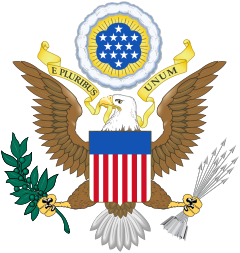
.svg.png)
.svg.png)
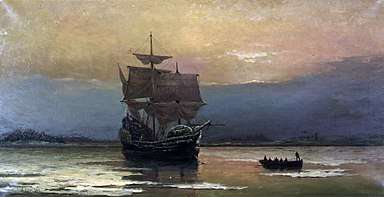
.jpg)
.jpg)
.jpg)
